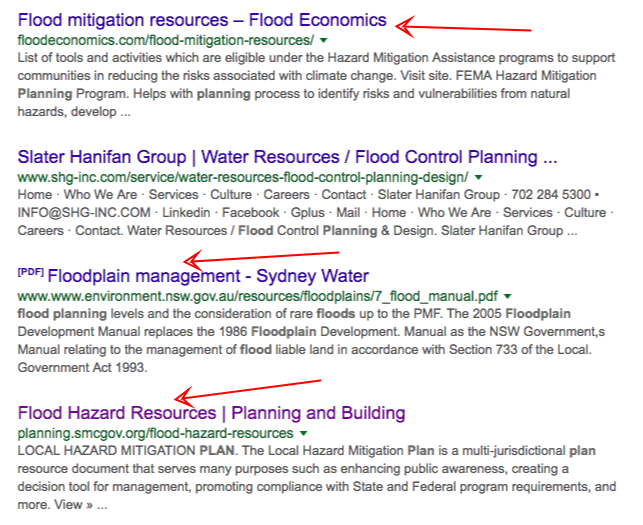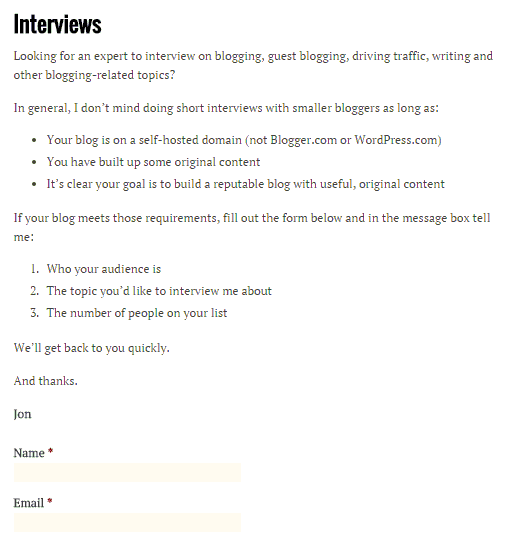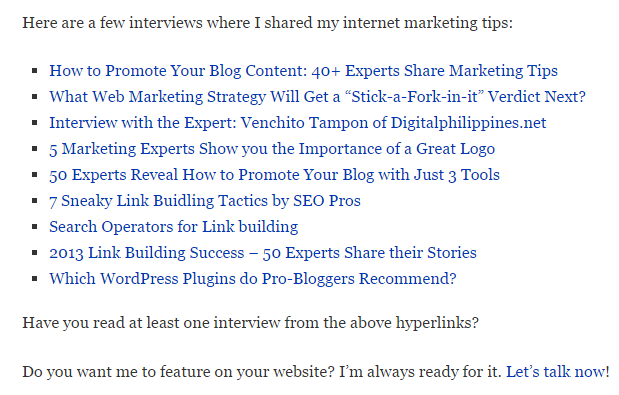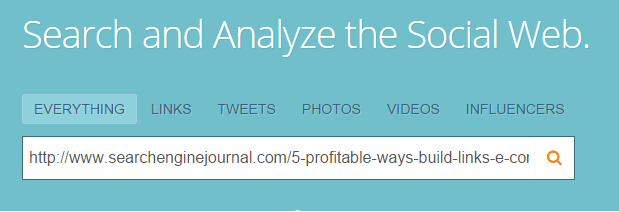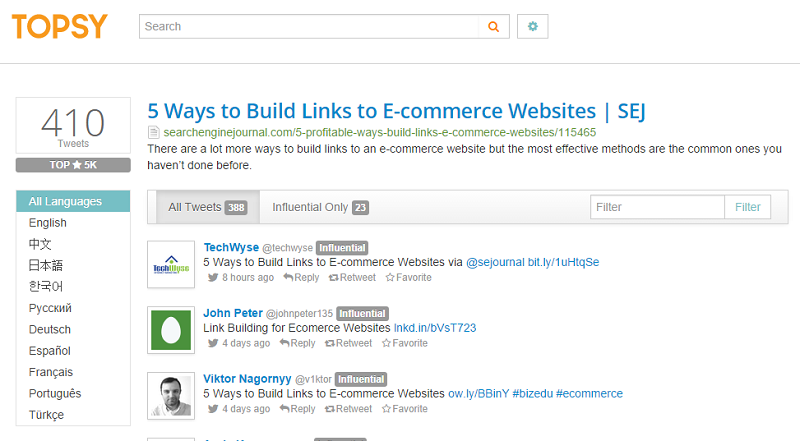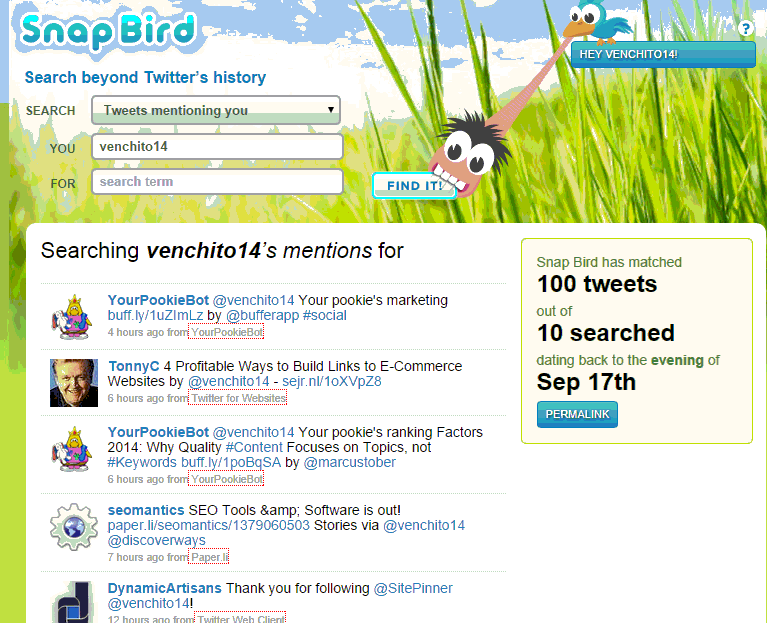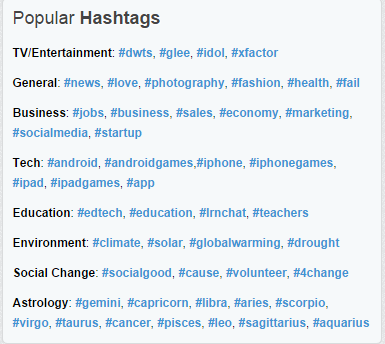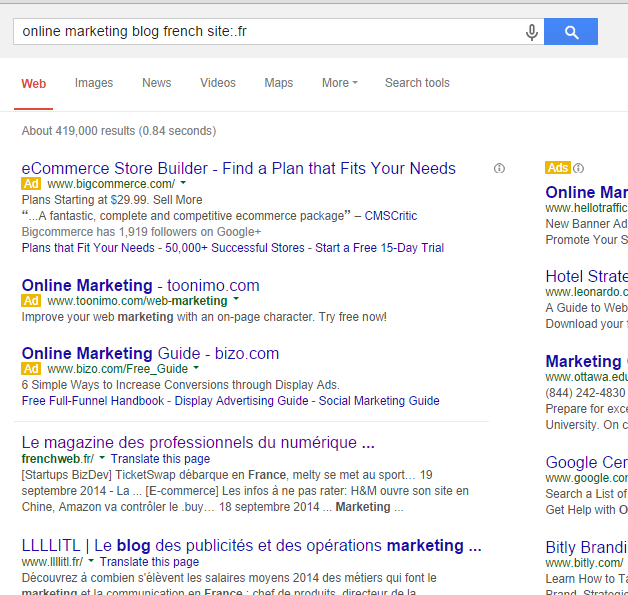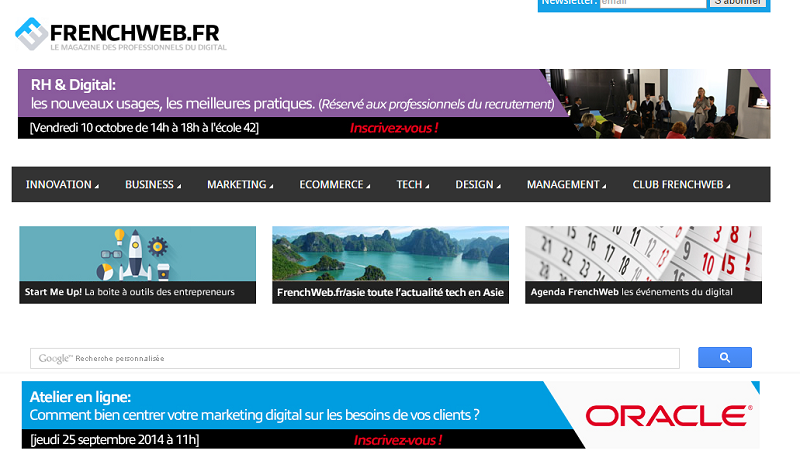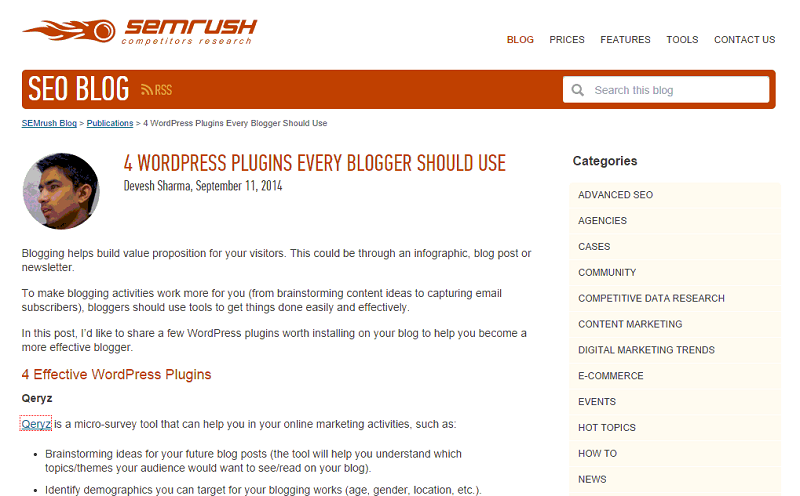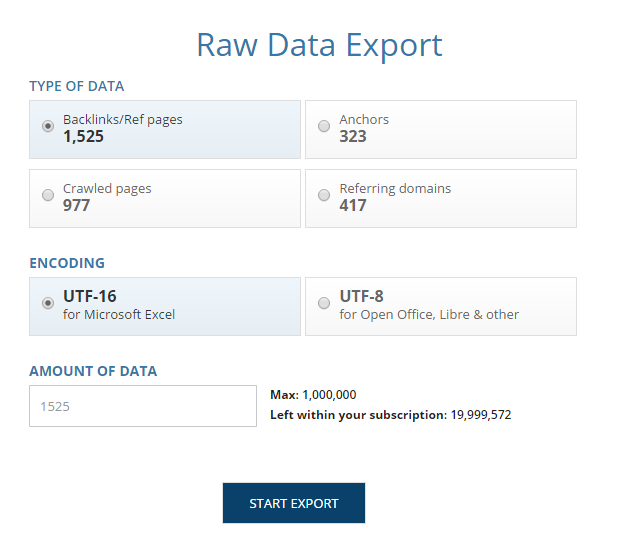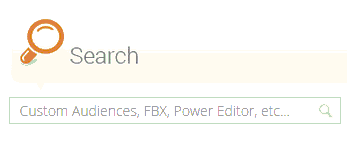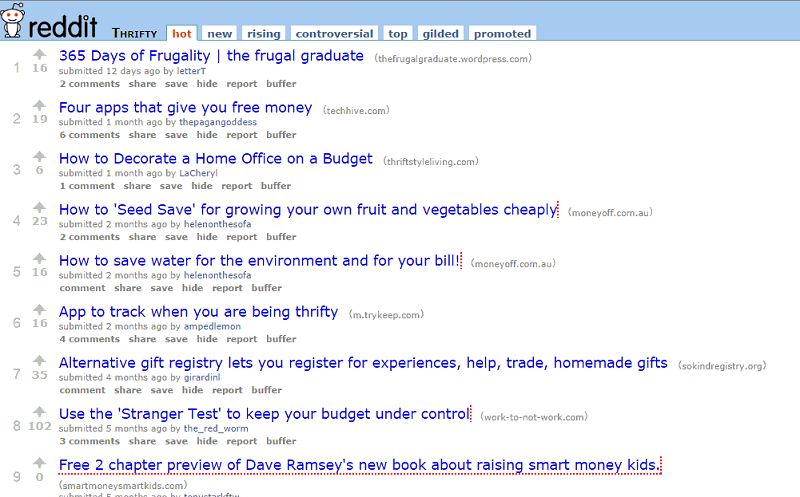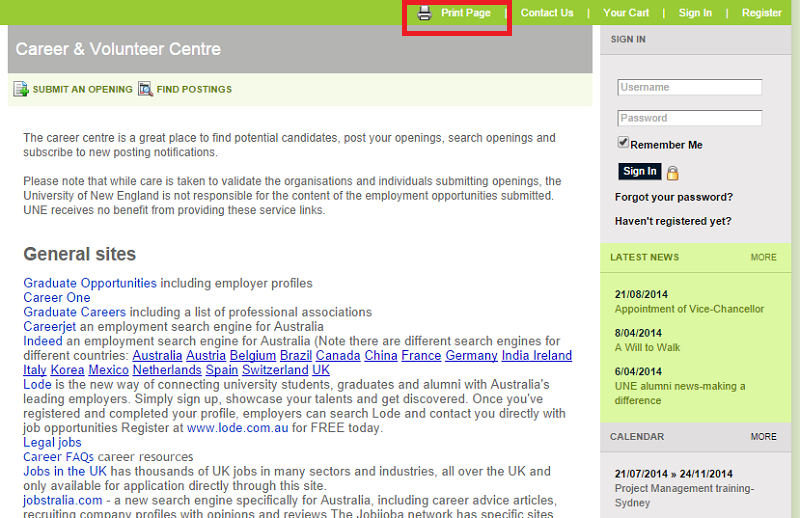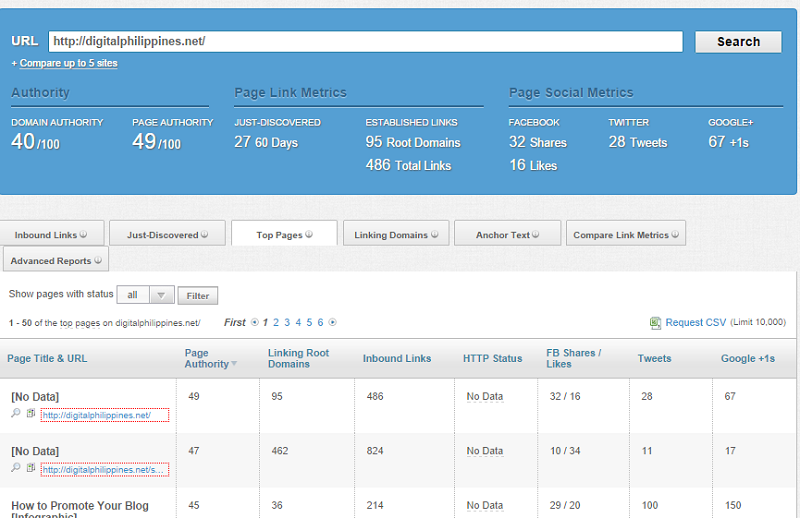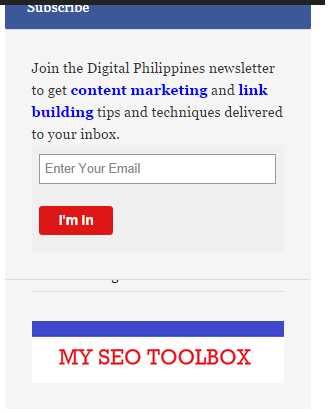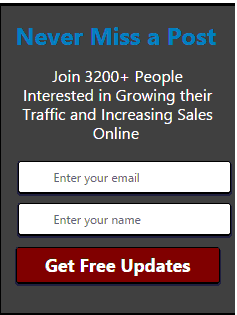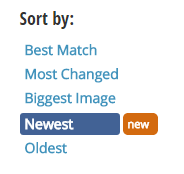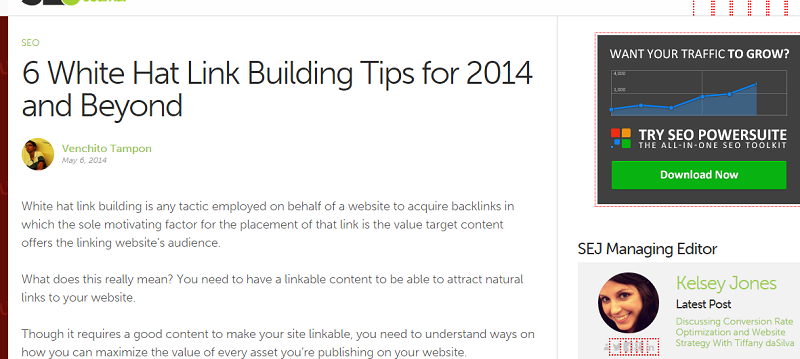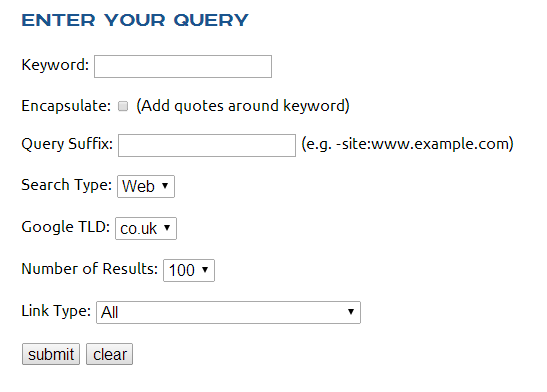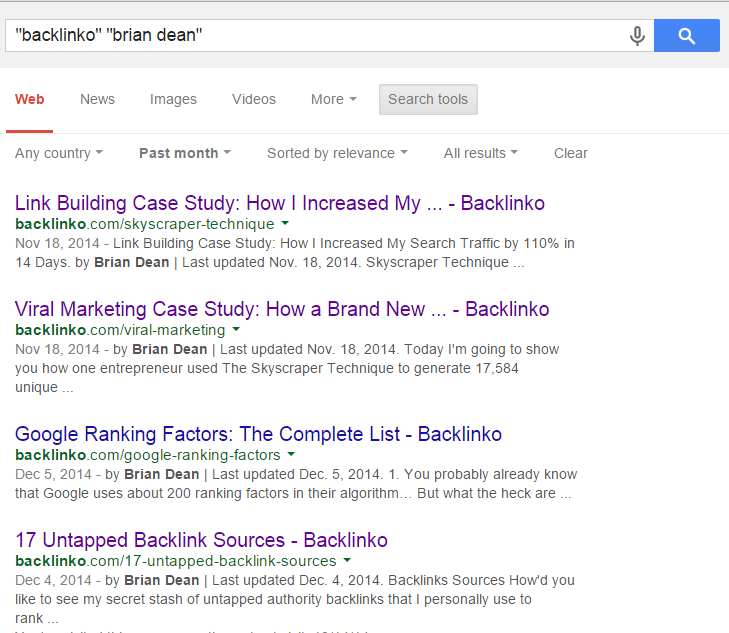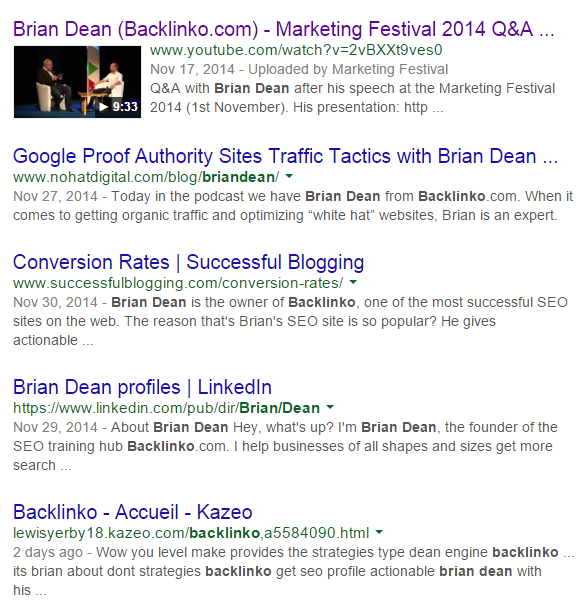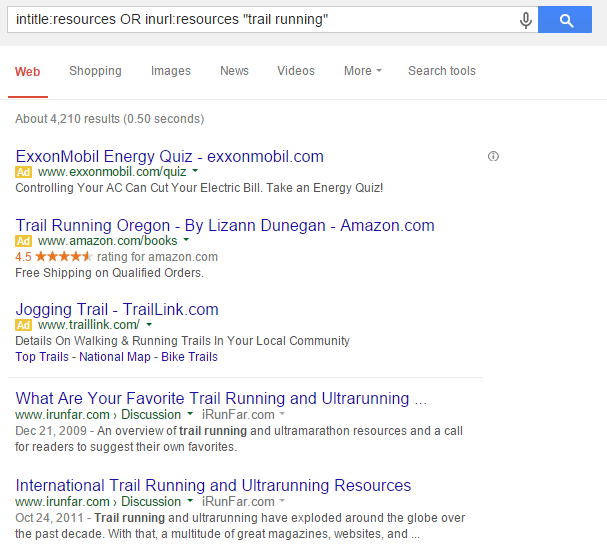Finding and Leveraging New Audiences for Links
Leveraging new audiences is incredibly helpful in growing your brand's online community.
It's a great way to drive more traffic to your site given that you will be able to absorb other sites' existing followers through links being placed on their pages.
Growth in terms of links and traffic is one of topmost priorities for seeking new audiences for your website.

In this post, I won't go deeper into conventional methods of finding and maximizing audiences of other publishers such as creating text-based content pieces (guest posts).
I'll be sharing a few insights to leverage your own existing content assets' reach and discovering other on-the-brand linkable audiences.
Let's get right to it.
BUILD SUBSEQUENT CONTENT ASSETS FOR KEYWORDS ALREADY RANKING
It's easy to dive into creating content assets for other publishers. As relevant as they are, it's always a practical way of increasing your brand exposure for people who might find your content useful — and eventually capturing your content because of the value your content has been able to provide.
However, there's a probability of missing out opportunities your content assets have gotten success with already.
You can start by looking at your site's top ranking pages — pages that have ranked well not only for their target keywords but also for other multiple keywords within a singular topic.
SEMRush is a great tool in discovering these top pages through Organic Research.
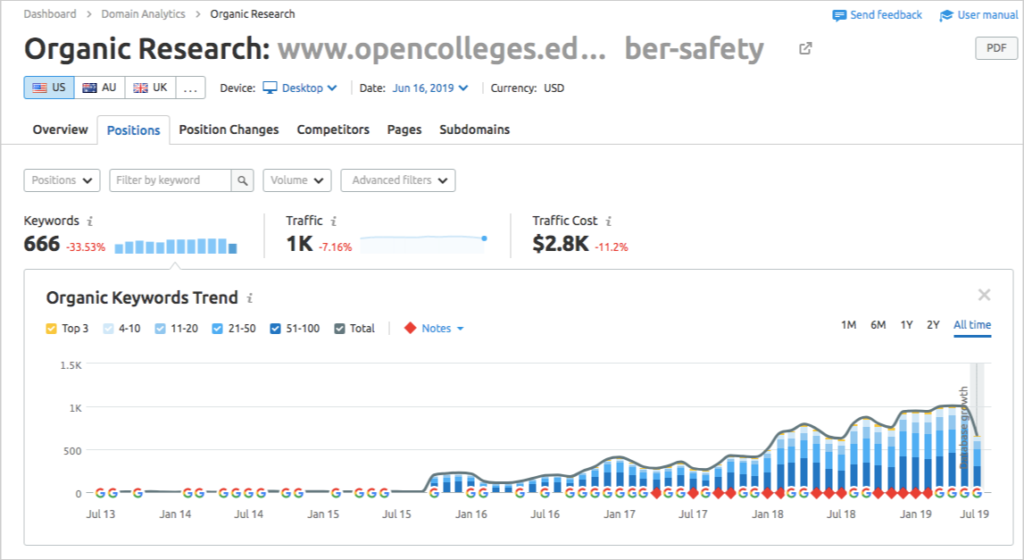
Go dig deeper to find what keyphrases those pages are ranking for. The Top Organic Keywords report shows you the entire list of keyphrases.
Filter the results of keywords by positions 21-50, which means you only want to see terms the page is ranking for on 21 to 50-ish range of search results.
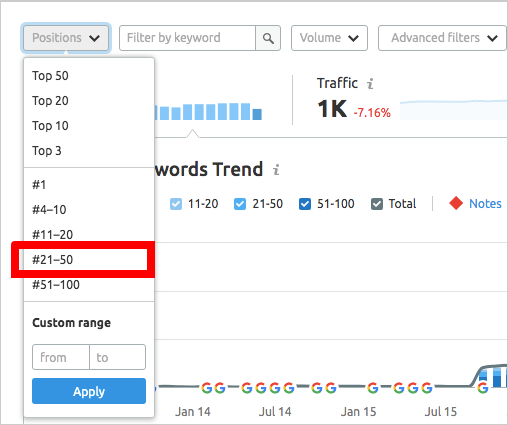
You will only see now keyphrases where your specific page is ranking from positions third page of results, and further.
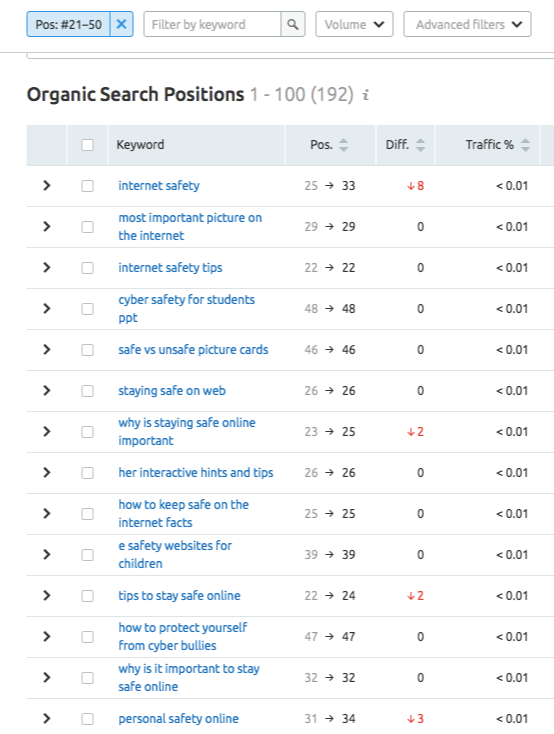
For example, this page, "Cyber Safety Guide" ranks for the keyphrase, "internet safety" while dominating for other 600+ relevant keywords. By checking, you'll see that there are keywords where makes sense to create subsequent articles just for them. Examples are cyberbullying pictures, malicious parents guide, and safety message ideas.
Your existing content asset may be ranking well for those keywords (as it is perceived as being relevant to those queries), yet new pages can serve well for intents for each individual keywords. This leads to more ranking opportunities and more visibilities for your site.
ON-THE-BRAND LINKABLE AUDIENCES
In the hopes of building resource links, a lot of content publishers have started creating a series of content assets for different linkable audiences.
Given that these audiences are likely to link to your resource, as long as they fit the topic (e.g. ), it would be easy to create content, get links and grow your link profile.
For example, Affordable Colleges and DrugRehab have produced comprehensive guides for similar audiences (parents, teens, kids, teaching, PSTD, disabilities, etc..).
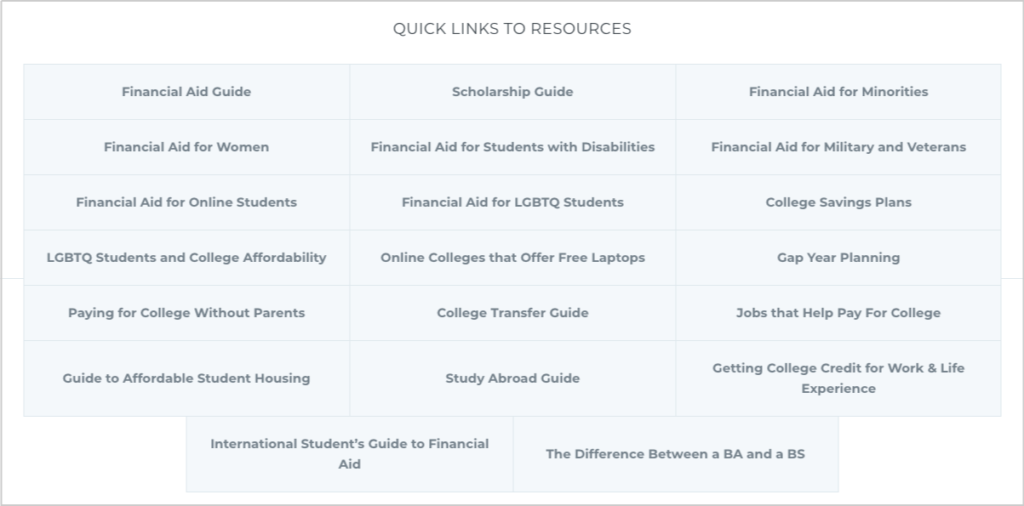
While this is a good link building strategy of publishing different guides for different linkable audiences, there will be some disconnect brand-wise between linkable audiences and your customer profiles, if not planned carefully.
Every content publisher has to understand deeply their customer profiles (from top-view down to their execution of content creation).
This is important in order not to go too far away from their main blog's target audience. It's easy to create content for cancer patients, but when your customer profile does not include that, it would just be an additional piece to your blog that disconnects people from visitors to customers and are less likely to bring people from point A to point B of the customer journey.
I've been doing consulting with SEO agencies and brands lately, and I constantly tell people not to stretch their brand too much for the sake of creating content pieces for contextual links.
Getting links from off-the-brand links pages can help drive referral visitors but may not actually convert into customers, as the main offerings of the site do not fit to their specific profiles. Brands may get a lot of links from different guides for linkable audiences, but may not help in lead generation or conversion-wise.
This is why SEOs and content marketing agencies find it difficult to get buy-ins from marketing teams, execs, and content teams of their clients. Clients want to target direct consumers, but SEOs and link builders want to produce assets for other audiences.
The key here is to exhaust all possible means of identifying the most relevant linkable audiences in your customer profiles (or if your direct customers are also one of linkable audiences - that would be a big advantage on your part).
Then, go look for other linkable audiences that are still relevant to areas within your customer avatars. Reaching far from your main customer audience (five levels sidewide relevance-wise) isn't practical when investing resources for content creation.
You can check out these comprehensive guides on link building and a cheat sheet of search engine queries.
LEVERAGE NON-COMPETING BRANDS
Another way of increasing your reach through finding new audiences is to find any non-competing brands in your industry.
If you offer very specific products or service (definitely targeted to niche customers), there are three ways you can approach this:
- Find similar brands but are serving other local cities.
- Find brands with the same target audience but provide different offerings.
- Find brands of different types (affiliates, eCommerce blogs, etc..).
For example, if you own an affiliate blog for dog owners, you can leverage eCommerce stores that directly sell dog food, supplies, or equipment.
If you offer personal injury legal services in Texas, find medical institutions with the same target audience in your target local city.
LEVERAGE NEW AUDIENCES
By looking at the locality, website type, and expanding your industry horizon of topics, you can discover content opportunities you can take advantage of. Invest in building content assets on your blog first, then produce relevant pieces for other relevant sites as well.
By leveraging new audiences, you don't lock your brand into the limited efforts and resources you can reach by your own. You tap into other brands or online communities with existing reach to targeted visitors.
How to Find The Most Receptive Linkers In Your Industry
Outreach for any marketing initiatives including link building requires proper timing. When publishers are at the moment when they need what you offer, the likelihood of getting the link increases.
It is at a content creators' most receptive timing that they consider an exemplary content, which is way more effective than begging them for links when you start promoting your online asset.
In this post, we'll cover the factors that would help you and I determine the highest receptivity of potential linkers.

Normally, writers and publishers from niche blogs and other publications don't have a non-stop writing schedule for their online content. They have their own sets of phase - from content ideation, research for references, drafting, proofreading, and publishing, which allows them to secure the finest quality in every detail of its content creation process.
Consider the intent of a content creator performing a search query for his research. He includes parts of other online references - pages from other websites that will be of useful information to the content he is producing.
Content parts may comprise of any of the following:
- Answers to questions potential customers wanted to know
- List of industry jargons and lexicons
- Reactions and counter-arguments to the latest big trending industry news
- Industry concepts that require explanation and guides
- Updated national or local laws, regulations, and implementations (i.e. PH's tax table)
You can use Ahrefs' Question Feature for discovering questions your users are looking for in your industry. There are questions where there is a need for a more detailed article or even a shoot a video for better content consumption.
You may have to find and hire academic and industry experts to help you with industry jargons - pull them off and create a list of terms and definitions that will be of use to content publishers. There are a lot of glossaries. So, one you should be putting out must cover more entries and should have highlight examples that are most commonly used in the market.
Influencers (e.g. vloggers) now have the luxury of producing video reactions to latest trending news that would get buy-in and support from other content publishers (if done with finesse quality - i.e. practical advice or information on the subject matter).
For retailers, you can invest in content pieces that compare leading products or brands in your space. Search for any productA vs product B high search volume phrases in Ahrefs and start determining if it's worth producing into content. I mostly see fact charts and tables for comparisons, but if you want to stand out, you can make little efforts to interview experts for impartial reviews or opinions.
TARGET FRESH PROSPECTS
When a website has been updated just recently - i.e. last week, last month or even last 24 hours, there is a higher likelihood for response to an irresistible pitch.
With very little efforts, one can find these very hot link prospects.
If you're doing link prospecting for a while, you would find Tools filter to be extremely valuable in refining your backlink targets. You'll be able to see newly published pages.
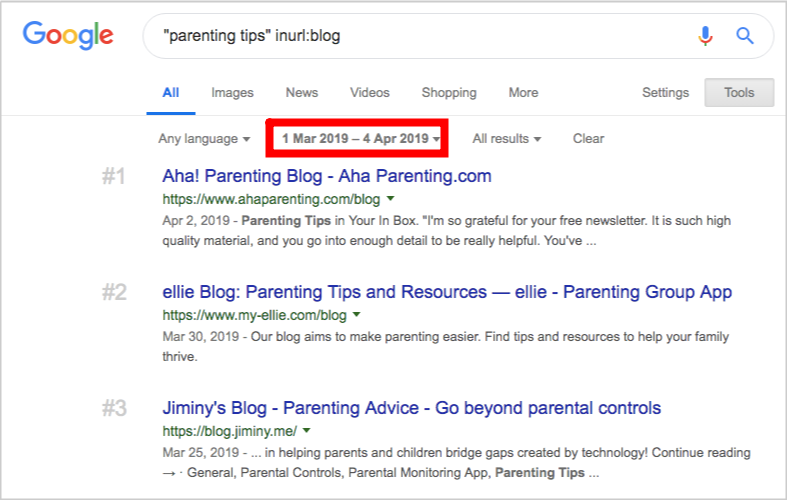
There are a lot of things you can leverage on this part, but one you can completely observe is there are many industries where there are missing good quality photos. So if a recently published article has a mediocre image, you can quickly send a pitch providing a list of high-quality images they can use for their blogs.
Independent bloggers normally don't have graphic artists on their team, so this is a good way to appeal to content creators in your space.
If you have a plethora of high-quality images, you can do a massive reverse search for these visual content. This is to ensure you monitor any non-attributed images you can reach out to and ask to credit images to your website.
FIND JOURNALISTS SEEKING FOR CONTENT
Sending pitches to journalists who are looking for stories to cover on their publications requires a solid strategy for PR and link builders eyeing for big exposures. While it's an extremely difficult process for some, here are some guides I've found to be helpful for pitching journalists:
Journalists have timing where they are also at their highest receptivity. This is true when they already start looking for industry people to interview..
HARO is a great place to discover journalists seeking for stories your brand may be of interest. Another channel that is often underutilized is Twitter.
With a few Twitter searches, one can find enough available niche-specific story requests from journalists.
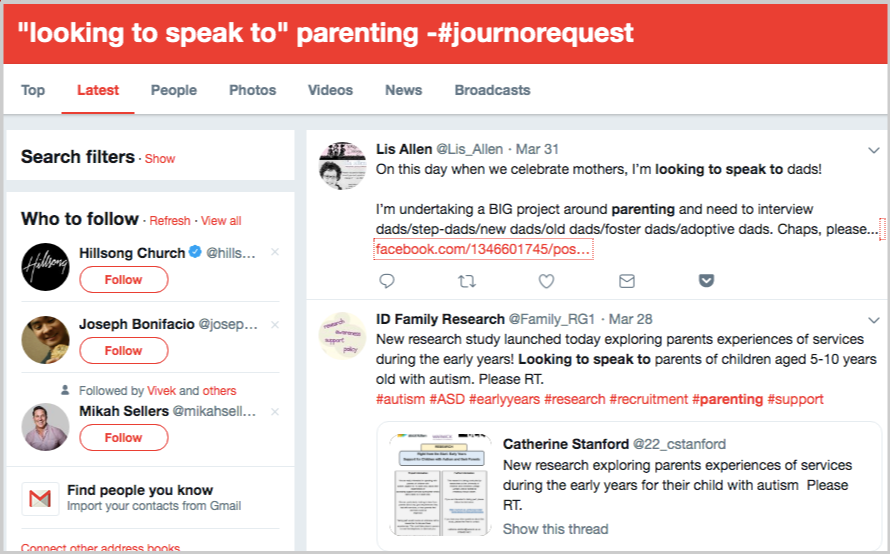
While most publication people would include #journorequest in their Tweets, you won't find this very often to be true.
Journalists normally use very classic terms that don't necessarily include the hashtag #journorequest. Here are some of the Twitter phrases you can use for discovery:
- "looking to speak to" -#journorequest
- "looking to interview" -#journorequest
- "is there anyone" expert -#journorequest
- "can you recommend" interview -#journorequest
- "do you know" expert -#journorequest
There would be a lot of noise in Twitter search results, so you have to filter ones that are only journorequest and at the same time relevant to your industry.
One advantage of these non-common journorequest Twitter tweets is that they don't receive pitches as much as those users of #journorequest tweets that link builders and PRs reached out to.
HIGHEST RECEPTIVITY IN OUTREACH
We all aim for the highest receptivity in outreach emails. This is only possible if we are able to know and understand the stages where these content creators, potential linkers, and journalists are likely to respond.
With the above practical tips on strategic link prospecting for most receptive link targets, you'll able to expect more results in link performance.
Further Resources:
- Link Prospector: How to Get 3000 Prospects in 5 Minutes
- 30 Free SEO Tools and How to Use Them for Link Prospecting
How to Turn Undervalued And Forgotten Assets Into New Links
Links are being given higher preference as a ranking factor in search. It will always be that way as it contributes hugely in the ranking system.
Eric Enge's viewpoint on why links are such a great signal comes down to these three major points:
- Material investment of the one linking to the page - the effort to put a link on a webpage is higher than implementing a link in a social media post.
- Links serve as a public endorsement identifying the brand with the page being linked to.
- Links give way for visitors to jump from one website to another - a direct invitation to do so.
The importance of links in search marketing now gives rise to businesses allotting budget for this area of SEO.
It is a serious matter when an investment has been made. As such, one must maximize every content asset produced for the brand, whether that is a video shot, written words or audio.

One consideration is to turn your old and existing content pieces into new links. There may be underdeveloped, un-updated, and almost forgotten assets your team can search for, go back, and think of ways to reuse to acquire more links for your site.
How is that possible?
Here are some tips you can apply to your link building campaign to maximize whatever old and existing asset you have on your site.
IDENTIFY THE FIRST SET OF LINKERS OF UNDERPROMOTED CONTENT
Look for any underpromoted content on your site that has gained links in the past. You can use Ahrefs to find pages that have at least 10 good referring domains.
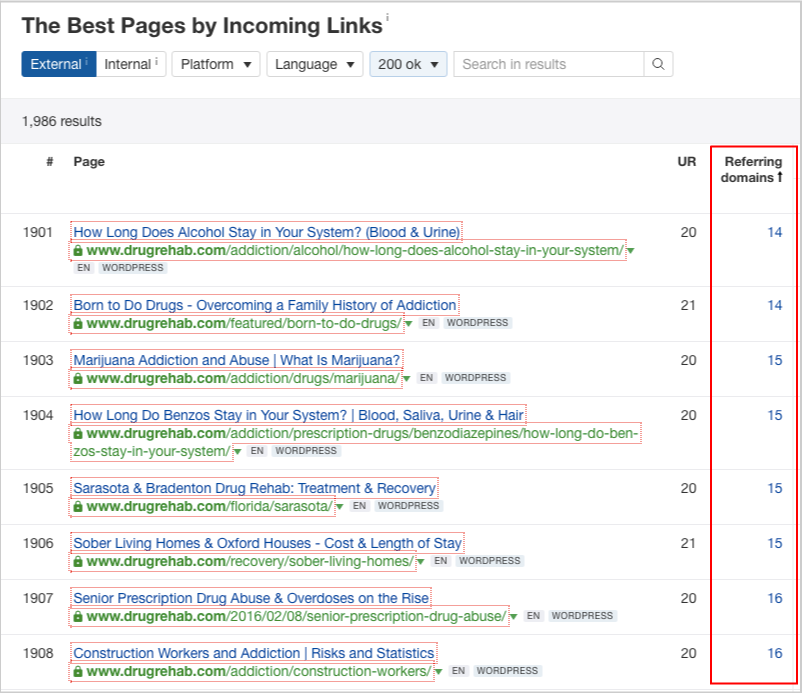
Check the links if they are built manually or are just syndicated from its original source or links from scraper sites. You have to ensure these assets succeed at one point of either attracting natural links from content publishers or acquired resource links through manual outreach.
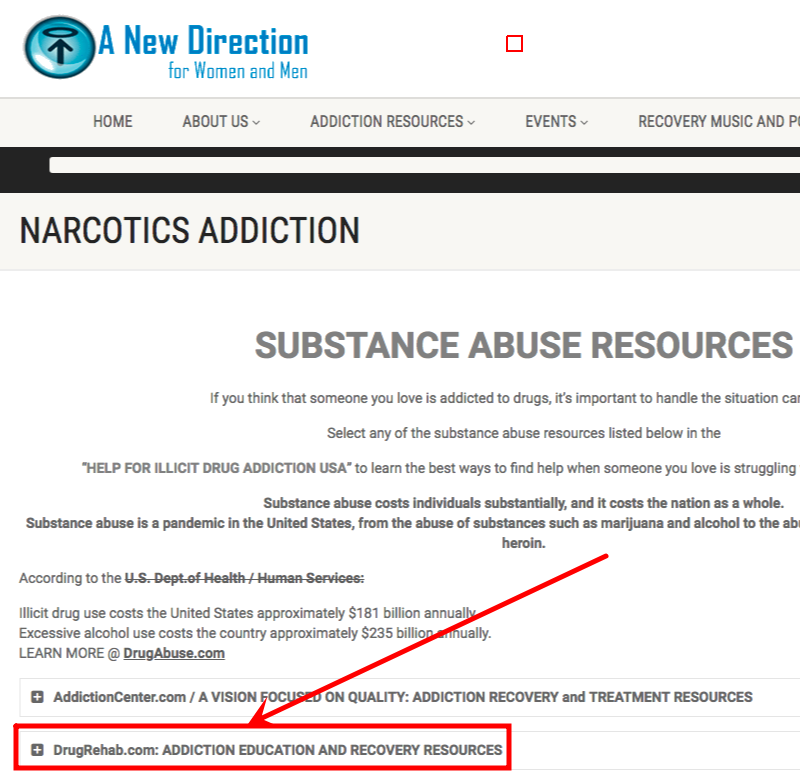
Can you see patterns of audience the underpromoted content piece has targeted? This gives you a clue as to which kind of blogs would be relevant to prospect and reach out to for links.
CHECK FOR ANY 404 PAGES LINKABLE CONTENT
For many reasons, there are linkable content assets that have been put down by the publisher or webmaster.
While some may not be useful anymore, there are timeless pieces that can be made live again to get more links to your site.
You can easily discover dead linkable content using Ahrefs' filter feature "HTTP code".

Assess the page if it's worth to republish by looking at the number and type of links it garnered in the past, timeliness of topic, sets of linkable audiences can be matched to it, and overall linkability of the page itself.
MATCH EXISTING CONTENT TO LINKABLE AUDIENCES AROUND THE WEB
With 601 audiences, there is a big possibility of finding congruence with your existing content to a specific audience who actually links from their curated or resource pages.
Through a moderate amount of outreach, you can turn your simple existing piece of content into a linkable magnet. Broken link building allows that, by finding pages that have defunct links which your existing content is a fitting replacement for.
The same broken link building process is applicable, the only difference is in the part of content revision — where content has to be targeted for a chose linkable audience.
REUSE OLD VISUAL ASSETS
Visual assets like infographics are being produced every day. While some succeed in attracting more than average views, there are many that flopped because of lack of promotion.
If there are old visual assets of your site or of your client, look at the links they naturally gained first time around. Take note of the types of websites that picked it up.
Assess if you can find similar websites within the same level of reach.
Given the amount of months or years pass without the visual asset being heavily promoted, there are newly emerge publishers you can reach out to for additional exposure of the content.
REFORMAT YOUR EXISTING CONTENT
There are many ways on how you want your existing content pieces to increase its link-worthiness-- either restructure it, repurpose (turn it into other content formats), or consolidate your thematically-relevant weak posts into a comprehensive guide on the topic.
By doing so, you establish the linkability of your content asset - helping it to be perceived as deserving for natural links.
You can also dig deep within your organization and find resources you can use or refine for manual outreach.
Here are some resources you may take a look:
- Frequently asked questions from customer service departments that can be refurnished as a FAQ guide — being added to an existing content
- Old newsletters with a curated list of resources, how-to tips, and sections, and interviews with industry experts or influencers
- Mini-ebooks distributed to potential customers
- Slide decks of speakers in your organization that can add extra context and points to an existing blog post or you may turn into a sort of "ask experts" series of content
- Internal training presentations that can be published as "inside the agency or business XY" signifying brand transparency.
- Employee knowledge base that can be turned into a common questions section on the website
IMPROVING WHAT IS IN YOUR HAND
Taking the effort to go through your content assets published in the past months and years may reveal opportunities you’ll otherwise miss if you simply just plan for new content creation.
Along with tips shared above, you can read this guide on content writing, content gap analysis, and this list of creative content promotion strategies.
Link Prospector: How to Get 3000 Prospects in 5 Minutes
In my work in SharpRocket, I often am asked what is the "best link prospecting tool" to scale link building campaigns for clients.
This post aims to answer that question.
Disclaimer: I'm not an affiliate of the tool that I'll be sharing with you - it's just that I highly recommend you try it out if you struggle with link prospecting.
There are only a few link builders that I respect in the industry because of their deep expertise and love for sharing insights that will best help the SEO community. Garrett French is one of them. He is the founder of Citation Labs, a link building agency and creator of Link Prospector Tool.
His tool can help semi-automate the search-query prospecting process that will definitely save hours of doing it manually.
Here's a walkthrough of how you can use Link Prospector.
If you already know how to use the tool, jump in straight to Feature Tips to get some goldmine tips.
Step 1: Create a Campaign
As soon as you sign up and login, you can start creating a campaign. I recommend that you name it after your Client or your Website so as not to get confused if you have several clients to work for in the future.
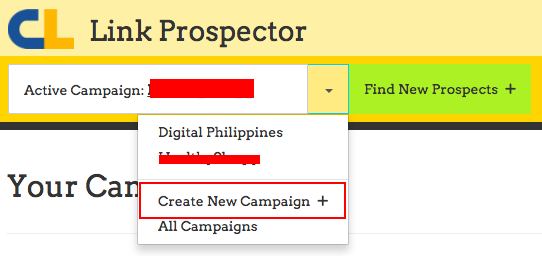
Step 2: Choose a Specific Link Type
Next is to start finding link prospects. Click on Find New Prospects in the Navigation bar.

Select the report type that suits your link building needs. For example, if you want resource or links pages, then choose links pages (pretty easy right?).
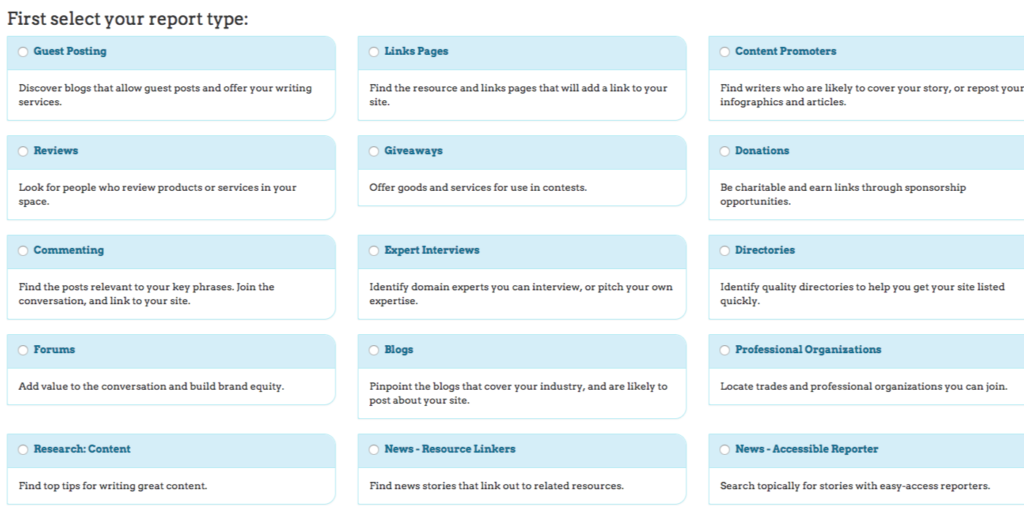
Click on Create Links Pages Report.

Step 3: Name Your Link Report and Set Advanced Options
I suggest naming your report under a niche such as snoring or flood planning. You can always go back to specific reports when you have another very specific client in the same industry or have a content asset on the same topic.
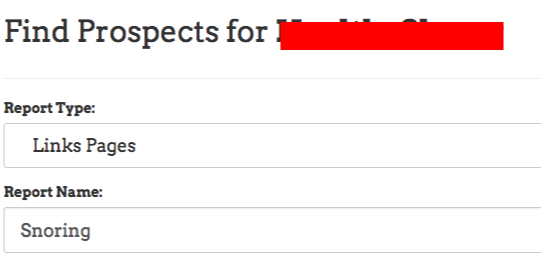
ADVANCED OPTIONS
If you want your link prospects to be very targeted, I suggest you choose customize search features on advanced settings.
Click on Show Advanced Options.

Let me pause a few seconds here.
You need to strategize your prospecting based on these options.

Let's check each one of them:
-
- Report Update Frequency - if you want your reports to be updated with new link prospects, you can choose update frequency as weekly, bi-weekly or monthly. But if you're doing an ad-hoc campaign, I suggest you choose Run Once.
- Language - don't change the default (English) unless you're tapping into Non-English markets.
- Select Region - choose the location you want searches to be queried from. This is best customized for country-specific link prospecting campaigns (e.g. tapping .co.uk backlink targets).
- Select Scope - leave it default if you're not targeting news pages.
- Select Depth - this allows you to choose how many results you want from each query. For example, if you type 4 custom queries and you choose a depth of 700, you'll get 2800 total results.
- TLD - choose the top level domains preferred for the results. They can be .edu, .gov, .org, .com, .us, .mil or other.
- Date Range - choose whether you want to get results from the past 24 hours, week, month or year.
- SafeSearch Filters
- Send Email Notification - choose whether you want to be sent the report to your email address or to another email address.
- Exclude Domains from - click or unclick Global Exclusions or Campaign Exclusions (more on this later).
- Research Phrases - include topical keywords to yield better search results. For more insights on non-SEO keywords, watch this video below:
Step 4: Start Prospecting and Wait For Your Report
When you have customize your report based on your needs in the advanced options and have included research phrases, the tool will give you its equivalent report cost, and show your available credits.
When you have decided your options are final, click on Start Prospecting.

Once you've submitted a report, wait for around 10 to 25 minutes for it to be ready. Do something else while waiting. The report will give you a number of results based on the number of research phrases and in-depth scope. For example, for 5 queries (research phrases) with 700 in-depth, it will give you 3500 prospects.
Here's what individual report will look like:
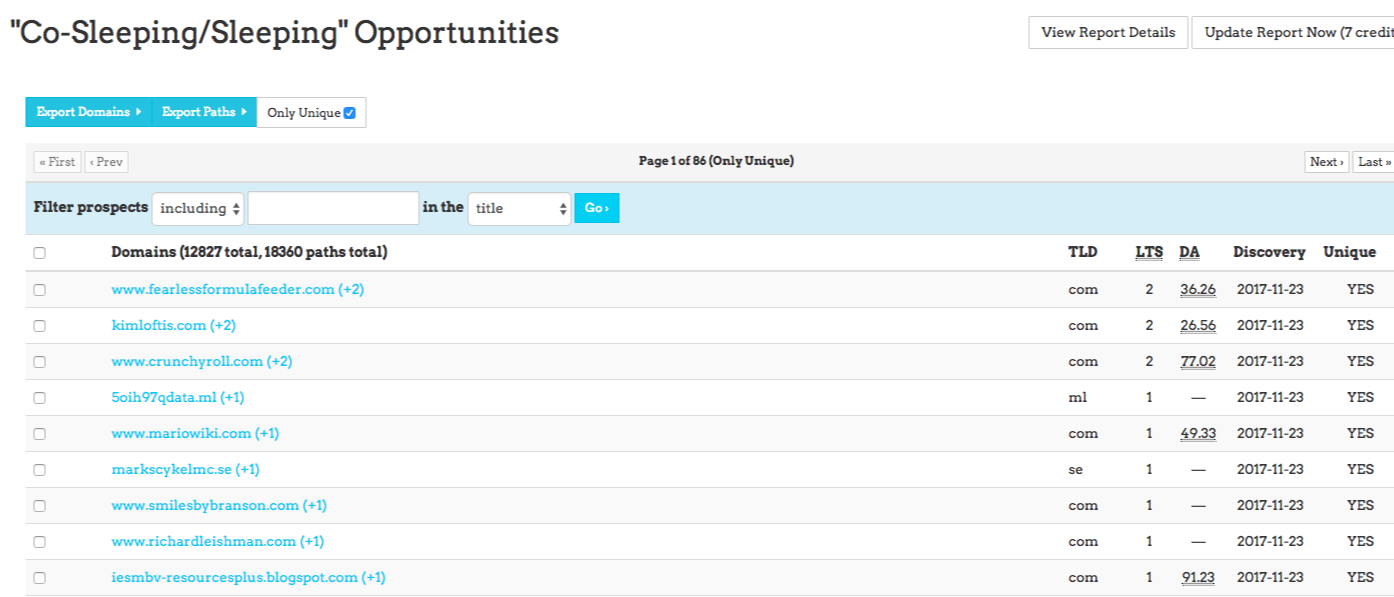
When you have run a few reports, your campaign page screen will look like this.

It shows you how many prospects you have for each report.
Step 5: Export Paths/Domains to Get Your Report
You'll see two options at the upper right side of your report screen, "Export Domain" and "Export Paths".
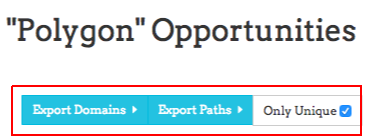
Export Domain feature gives you a list of the domains found in the report as a CSV file (e.g. sharprocket.com.ph) while Export Paths gets you a list of all the URL paths found in the report (e.g. sharprocket.com.ph/links-pages).
For each domain, there may be two or more URLs found that are queried based on your link types. See example below.
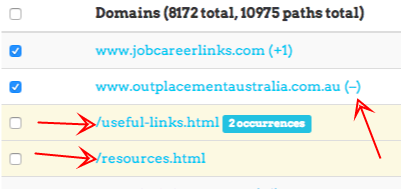
When you click on the number drop down, it shows you two URLs within the website.
I suggest you choose Export Paths for page-level link opportunities (resource pages, guest posts opportunities, sponsorships, etc..) and Export Domains for domain-level link targets that doesn't require you to target a specific page to get a link from (e.g. content promotion blogs).
Once you've exported URLs (for Export Paths), your CSV file when downloaded will look like this:
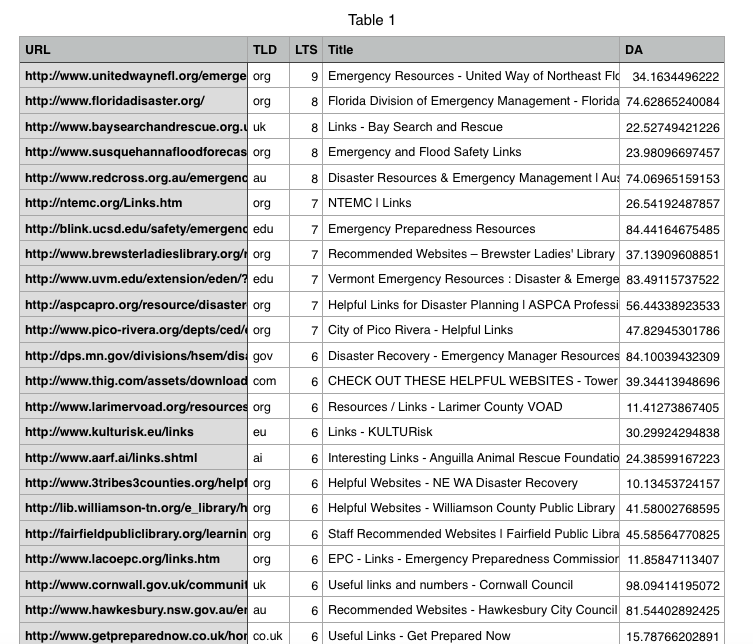
LINK PROSPECTOR FEATURE TIPS:
This section is to give you some tips on how to use Link Prospector more effectively helping you provide better targeted link opportunities.
The first tip is:
1. USE NON-SEO KEYWORDS AS RESEARCH PHRASES
If you have watched the video I've shared earlier, Garett French emphasized heavily about using non-SEO keywords or words as your research phrases in the tool. The reason is that the topical keywords can give you more page-level link opportunities, as they are more informational than commercial in nature.
One method that you can use is by doing a Google search for research phrases to check if they are more topical than commercial. If most webpages on the first page are commercial pages, you're less likely to get links.
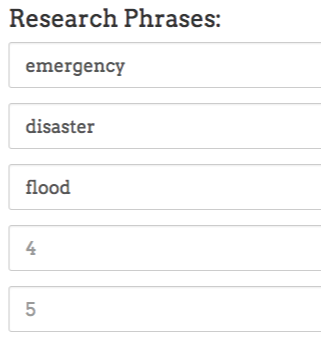
If you are struggling to add more research phrases, I recommend that you do a Google search for one topical phrase. And have a simple look at page titles and descriptions of URLs on the first page search results.
You'll then uncover phrases you haven't thought of relevant to your topical phrase that can be used as research phrases in Link Prospector.
Useful Resource: 4 Advanced Link Prospecting Techniques for Increased Efficiency
2. LEVERAGE .EDU AND .GOV TLD SEARCH FILTER
If you've been very specific with your prospecting, I recommend that you utilizeTLD advanced search option of Link Prospector.
For example, if you only want to find .edu and .gov links pages, it's better to choose .edu as your preferred TLD to filter results to only yield .edu link targets.

It's plain and simple.
3. MAXIMIZE GLOBAL OR CAMPAIGN EXCLUSIONS
Here's my recommendation:
Before you start creating a report, make a list of sites or pages you need to exclude from searching. These may include social sites like Pinterest, Facebook or Twitter or even the site of your client.
This aids you with the cleaning up process.
For campaign exclusions, I recommend that you get your list from backlink reports of your website generated from a link building tool like Ahrefs - the report is a list of links that you have acquired already for your website.
Make sure you exclude lost links in your campaign exclusions as you may still want to reacquire them in your outreach.
4. PROSPECT FAST BUT QUALIFY BETTER
The hard work isn't exerted in using the tool, but primarily on what you do after you have collected thousands of link opportunities in your hand - that is qualifying them.
Prospect fast but qualify better.
The tool gives you the edge of scalability. But the work doesn't stop there. You have to qualify each and every link target based on relevance Otherwise, it'll be difficult for you to acquire links from them (irrelevant to your niche) or most of your link opps will be too bad (not authoritative websites and spammy).
In addition, it's important to know the estimated number of quality link targets you can quality from a big report of links.
For example, in my list of 10,000+ unqualified pages, we've generated only 400 DA20+ niche-relevant link opportunities.
On average, we qualify 1000 prospects based on relevance and obtainability within 15 to 25 minutes. So the total time it took us to conduct relevance test for 10,000 pages was 2 1/2 hours to 5 hours.
That may be time-consuming to some of you, so I suggest that you hire a virtual assistant to do the task (a VA with basic skills charges $3 per hour).
With a good documentation/process (.doc) on how to quality each link opportunity, you can generate targeted possible links from thousands of unqualified ones.
5. PUT MORE EMPHASIS ON RELEVANCE THAN DA THRESHOLD
When qualifying link opportunities, some SEOs are heavy on DA numbers as their threshold. It's okay if you've got clients who look at and measure your deliverables based on that.
However, if you have the luxury to strategize on yo ur campaigns and its results, I suggest that you give more emphasis on relevance over DA because if not, you'll miss out on good opportunities.
Tip: Educate your clients regarding link metrics.
In conjunction to this topic, Jon Cooper killed it with his tweets:
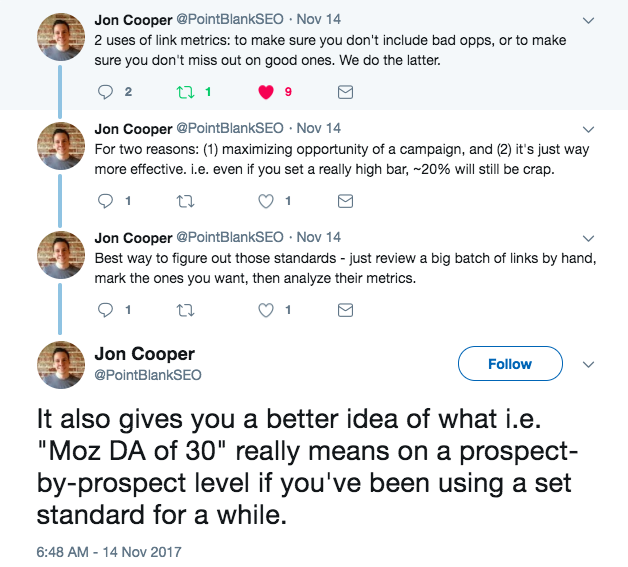
If you liked this post, subscribe to our newsletter and follow me on @venchito14.
Need help with your link building campaigns? Check out our link building services here.
The Definitive Guide to Guest Blogging
For more than a decade, guest blogging has been by far one of the scalable link building tactics used by search marketing agencies, bloggers and business owners to get backlinks for their own websites.
Also known as guest posting, guest blogging is the practice of contributing a content piece to another blog, whether that piece is an article, visual asset like an infographic, video, or any other content formats that will serve the audience of the blog (guest blog).

There are many benefits guest blogging does for your website (aside from getting a backlink):
-
- Serves as a social proof you can include on your site’s landing pages (e.g. As Seen On or Featured In) or on your outreach emails when reaching out to other industry publishers (e.g. I’ve contributed articles to X, Y, and Z).
- Increases your brand followers in your social accounts coming from the other blog’s existing audience, which will eventually help amplify your future content assets.
- Generates assisted conversions (potential customers/clients) to your website.
- Improves search visibility of target pages for keywords you’re trying to rank for.
In this post, I will share my typical step-by-step guest blogging process from finding guest blog opportunities to tracking results of guest content.
How to Find Guest Blogging Opportunities
In guest blogging, your first initiative is to identify your market audience.
To help you define it, here are some questions you can ask yourself:
-
- Who are the direct consumers of my brand, those who will primarily benefit from my products or services?
- What are the other industries I can tap onto aside from my primary niche? (Brian Dean referred it as “shoulder niche”).
If you are a marketing consultant, you can ask your clients or get some data from their sales data for you to determine their target audience.
Check if your preferred industries have enough blogs to target for guest posting. You can be in a very defined niche, i.e. snoring, where you might only find a few blogs to pitch guest posts to.
In this case, you can prefer page-to-page relevance over domain-to-domain relevance. Here’s an image to explain what this means:
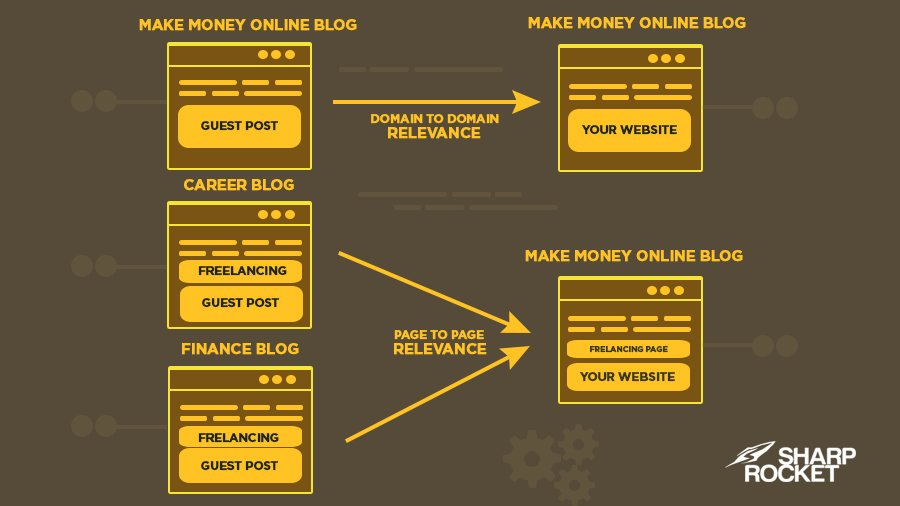
Once done, proceed to finding guest blogs.
There are many sources out there that you can use to come up with a list of websites to target for guest blogging. To name a few:
-
- Google search (using search queries such as inurl:”write-for-us” “snoring”).
- Portfolio of industry guest bloggers (“guest post by” “Ryan Stewart” - fastest way of generating a list of guest blogs by checking blogs where an active guest blogger contributed posts to)
- Twitter search (using search queries such as “guest post” “snoring”)
- Contacts of other industry publishers (exchange list of guest blogs with a niche blogger).
Recommend resource: Search Engine Queries Cheatsheet
The best way to save time in guest blog prospecting is to qualify websites as soon as you landed on them.
1. Check estimated organic traffic
You want to contribute content to a blog that markets itself. This ensures that your guest post will have a high lifetime link value - which means that it remains to provide direct benefits to your website even after the first burst of traffic it’ll get once published.
Use SEMRush to get an idea how many organic visits a particular blog gets every month (estimate).

Tip: A sudden drop in the blog’s estimated organic traffic may indicate penalties it received in the past.
2. Review the blog’s engagement status
The average number of quality comments a blog receives for his articles is a good indication of how engaged his readers are with his blog.
See if the blog has a substantial # of comments by simply checking his recent posts.
3. Authority and trust
How authoritative and trustworthy a site isn’t accurately measured by metric tools available in the market such as Moz’ DA and Ahrefs’ Domain Rank.
However, having a benchmark (e.g. DA30+) gives you the scalability you need to quickly qualify blogs as you landed on them.
Tip: Don’t use DA/Ahrefs DR for blog qualification alone. There are a number of blogs with low DA but have a high estimated search traffic (as measured by SEMRush’ SEPrice)
How to Pitch Guest Blogging Ideas
Your next step is to pitch potential publishers with content ideas of your guest posts. Effective guest blogging involves brainstorming for the right content ideas suitable for a guest blog.
Here are a few ways to generate guest post ideas:
-
- Topics listed in guest blogging guidelines (do a Google search for site:exampledomain.com guest blog guidelines - ensure their preferred topic ideas is your first priority).
- Blog’s previous articles (site:exampledomain.com “topic”)
- Blog’s categories (for page-to-page relevance)
- FAQfox (most commonly asked questions)
- Buzzsumo (most shared content in the industry)
- Ahrefs (most linked-to-content based on the # of unique referring domains)
It will help if you organise a list of guest blogs together with the following details:
-
- Domain Name
- DA/Ahrefs DR
- SEMRush SEPrice
- Contact details (name, email address/contact form) - see how to find email addresses guide
- Guest blogging guidelines link
- Content idea #1
- Content idea #2
- Content idea #3
Pitching Best Practices
Whatever outreach platform you use, it is an effective way to personalise your pitch while being efficient in sending outreach emails.
Always address the blog’s owner with his/her name (e.g. Hi Andy).
Include three content ideas (customized for the blog) in your outreach email.
Provide social proofs such as links to your recent guest posts, more importantly, if you’re trying to pitch to high-tier industry blogs. Write a few sentences how these guest posts did performed (# of comments and social shares they received).
Compliment the guest blog when it’s only applicable such as when the blog has a good webpage design). Be authentic at all times.
Pro Tip: Prioritize your guest blogs based on their authority and trust. You can personalize high-tier guest blogs a little bit more by providing feedback or opinion to one of his recent blog posts.
Further Reading:
Definitive Guide to Blogger Outreach
Blogger Outreach Guide by Ahrefs
How to Write Guest Posts
Drafting is important in guest blogging as it basically guides you (or the content creator) on structuring the guest post based on:
-
- Level of audience the guest blog caters to (beginners, intermediate, advanced)
- Type of audience they’re writing for
- Type of content they’re writing about (list post, case study, tutorial, etc..)
The topic idea that has been accepted by the blog owner should be well-written in the format and context of the details listed above.
It is also important to check the blog’s guest blogging guidelines for other important information, such as the tone and person point of view, that must be taken care of while writing the guest post.
There are two ways to succeed in writing a guest post: do-it-yourself or outsource it to a freelance writer.
DIY (Do It Yourself)
If you want to have a full control over the content, it is a great idea to write the guest post by yourself.
One approach you can consider is dividing the guest content creation into three different phases (drafting, researching and final writing).
You can schedule each phase on different days to help you focus only on one task.
Use Trello to manage your tasks. Personally, I create boards for To Do, Doing and Done to streamline my process in content creation.
Tip: Invest in grammar checking tools like Grammarly to semi-automate proofreading and ensure the quality of your guest posts.
Outsource it to a Freelance Writer
For agencies, one option to scale content creation in guest blogging is to hire freelance writers.
Websites like Upwork, Onlinejobs.ph (Filipino writers) and Facebook writing/blogging groups are sources where you can find quality writers.
Another approach that you might want to consider it is reaching out to bloggers and publishers in your industry and ask if they are doing freelance writing. They may charge higher than the usual freelance writer but the quality of writing will best suit for the guest blog.
Editing, Revisions & Final Publishing
Before submitting your guest post, it should be part of your process to check if there are any corrections that must be made to avoid early rejections to your content by publishers.
For the author bio, make sure you include external links pointing to your target page (homepage or a linkable asset you’re trying to increase visibility with).
Request to publishers, if possible to include your author bio at the end of the post instead of placing it in the usual “author bio box”. In my own experience, contextual “author bio” links gives more link value than a link from an “author bio box’.
Tip: Include internal links in your guest posts pointing to a relevant content within the guest blog. Having the webmaster do less work is a big plus.
Some publishers won’t allow you to link to a conversion page (e.g. product page) - in this case, you may include a link to a category page. This is a good approach if you want to flow link equity down to your deeper pages, such as your product pages.

Another approach that you can text is including a “guest post lead” or “expanded guest post” at the end of your post.
Expanded guest post or “guest post lead” is an extension of your “guest content” that provides more information on the topic not included in your content (e.g. 3 more advanced tips on X, free cheat sheet, data/report or summary that covers the topic in more details, etc..).
Below is an example of an expanded guest post that generates a good number of email subscribers for SharpRocket.
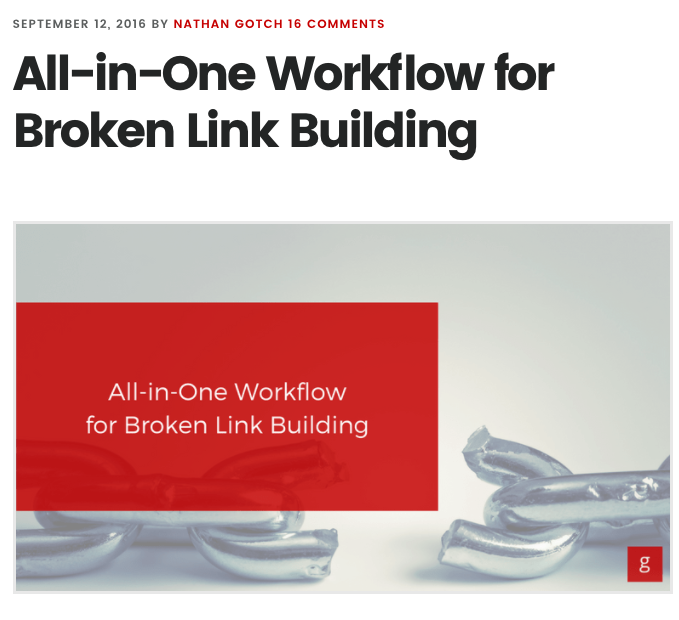
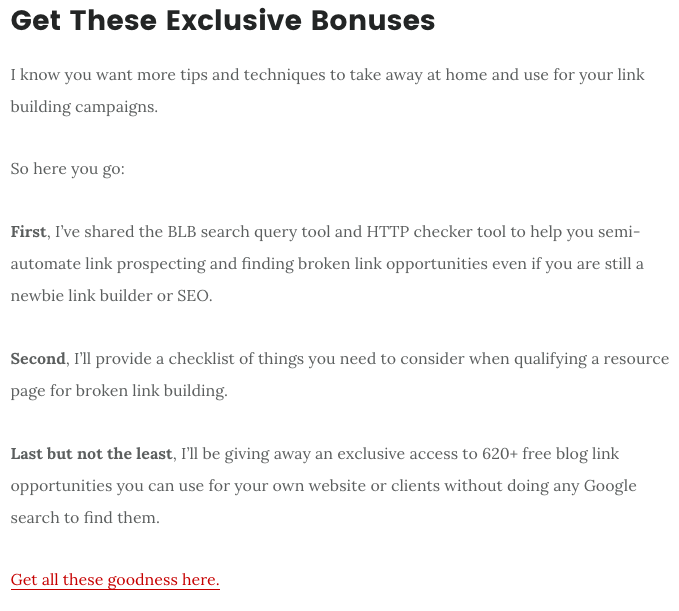

Personally, I prefer to create a “custom page” to be linked to from a “guest content” (see example below).
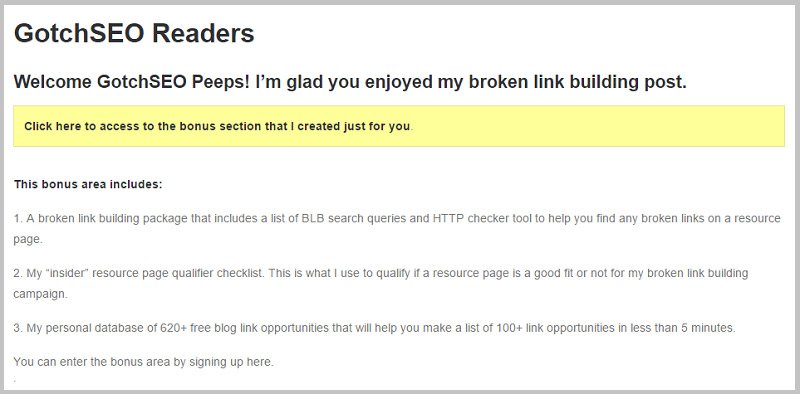
When you have the content ready for submission, it is best it to send your post in HTML aside from directly attaching the document in your email. This eases the work of the publisher to upload the whole content and properly link to certain pages.
How to Promote Your Guest Posts
Publishing your guest posts is only 50% of the battle.
It is best to promote your “guest content” once published on the target blog.
Here are my favorite ways to put more eyeballs to guest posts:
-
- Write a “promotional email” sharing your latest guest content and send it to your email subscribers.
- Get more visibility by distributing your content on different social platforms.
- Link to it from other external web content assets, like guest posts on other industry blogs.
- If budget fits, invest in promoting a guest post through Facebook advertising (only when you have secured it on a high-authority blog).
How to Track Results From Guest Blogging
No one succeeds without tracking results of work.
Identify which of your guest posts helps achieve your business objectives. It will be more beneficial for your brand to land more solid links from them (and more brand exposure) by regularly supplying with “guest content”.
Create a Custom Report in Google Analytics (Customization - Custom Reports).
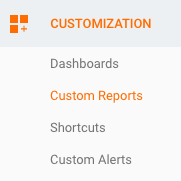
Click “Source” and “Landing Page” for Dimensions and “Goal Value” and “Users” for Metrics.
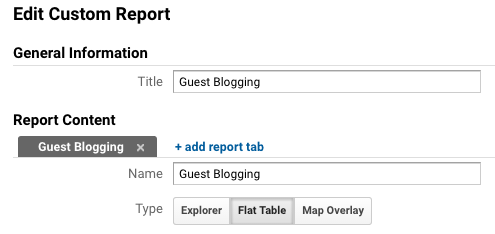

For Filters, click “Source” and type in the domain name for exact value.

Then click save.
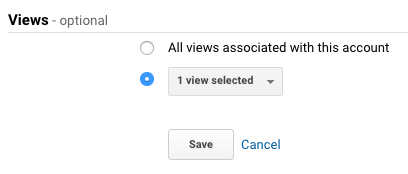
You will generate a custom report wherein you can get insights on the following:
-
- Number of users each guest post received for a certain period of time.
- Which pages (Landing Page) users landed on coming from the guest blog.
- Business value these referral visits/users generate on your website (depends on your custom goal values).
If you have setup a custom lead magnet/page on your website where referral users from guest blogs will land on, you can check how many referral visitors have converted into email subscribers.
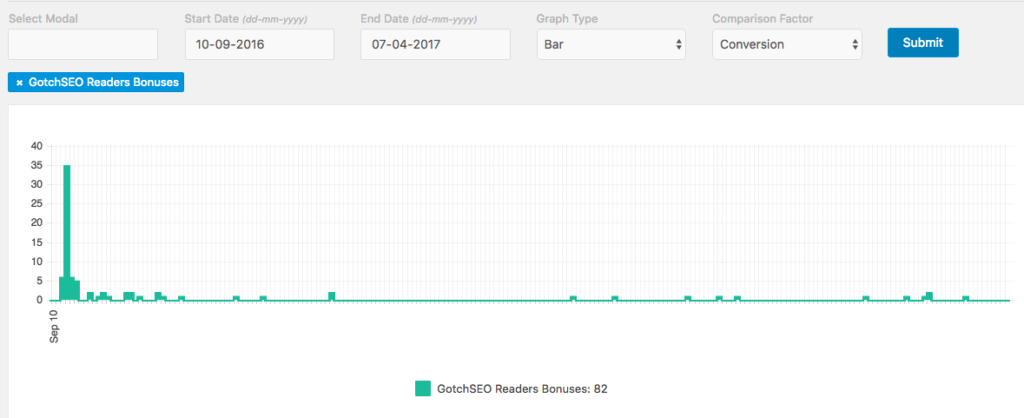
Personally, I use ConvertPlug to create lead magnets and to track the # of new email subscribers these guest content pieces generated.
Tip: It would be a best use of time to only create a custom lead magnet if the guest blog has high potential to drive converting visitors to your website. I suggest you check how many estimated organic visits the guest blog receives on a monthly basis using SEMRush.
Leverage new opportunities from guest posts
To further see the business value of your guest posts, check if there are referring links to your guest posts as well as positive mentions of your brand (right after these guest content have been published).
Reach out to these new linkers for opportunities to collaborate on content (guest post) or get exposure in other ways (podcast interview, getting featured on link roundup, etc..).
TL;DR
-
- Prospect for guest blogging opportunities using search engines (Google), Twitter and/or reverse engineering industry guest bloggers.
- Check the blog’s estimated organic traffic using SEMRush.
- Check if the blog receives quality comments on his content.
- See if the blog has an authority and trust using metrics like Moz’ DA or Ahrefs’ DR.
- Pitch bloggers/publishers with three or more customized guest post ideas for their blogs.
- Create a draft of the “guest content” based on the chosen topic idea of the webmaster.
- Build the content either by doing it yourself (DIY) or outsourcing it to a freelance writer.
- Ensure quality of content by checking its information as well as add important details such as author bio, external links to your target page and internal links to guest blog’s relevant content.
- Promote your guest content to your email newsletter, social media accounts or on your other guest posts.
- Track # of visits and conversions generated from your guest blogging campaign using Google Analytics and conversion monitoring tools like ConvertPlug.
25 Creative Content Promotion Strategies
If there is one thing you shouldn't forget about content marketing, it is implementing a solid and creative strategy to promote your content assets to your target audience.
A strategic content promotion plan would help you in so many branding activities, such as:
- Building communities (sub-groups of your target audience) that are exposed to your brand, which can help your future content get social shares in its first days after launch.
- Increasing the probability that bloggers in your space would link to your content (especially if your content is worth sharing to their readers).
- Engaging with popular media outlets in your local and niche vertical who would be interested to cover news or stories about your brand, which would be made easy if they’re attracted to new information or ideas from your content.
- Generating leads/sales through referral links from popular blogs/sites and connections built with influencers during the process of promoting your content.
If you already decided to invest your time and effort in showing your content to your target audience (especially those who still don’t know your asset), then you can follow at least ten of the content promotion strategies I listed below.
1. Multiple-effect email outreach
Content promotion through outreach is done in a one to one person basis (unless you’re doing an email blast for your campaign).
If you send 100 emails and you get a 10% click through rate, it means that you have an additional 10 visitors on your site (assuming we exclude those people who were referred by your recipients to visit your site as well).
The chances of getting more visitors who will likely to share your content depend on the number of recipients and emails you send to them. The larger your list of recipients, the more new visitors you should expect to see in your Google Analytics account.
You can make this 1-to-1 email outreach work more effective by adding a few texts to your email template.
You can actually increase the chances of getting a few more visitors from a single email using this simple approach.
How?
Step 1: Find generic branded emails in your list of prospects. Examples of the types of emails you should look at are:
Step 2: Add these simple lines to your email template (beginning and end of your email).
I noticed that your team tweeted a [topic] post on [Site Name].
Happy to hear a feedback from your team.
Step 3: Add this subject line to your email.
A post that your team might want to see
Step 3: Click the send button (or schedule your email if you are used to it).
Because you allow your email to be read by a team, you have chances of getting more shares from each person in that group (once they passed it on to one another). Additional visitors to your website and followers would be possible if your content captures their interests.
2. Invest in building interview opportunities
Interviews are open doors to show off your expertise and improve your site discovery by allowing people to visit your best pages/content (which will help them decide if they want to follow your brand in a regular basis).
How to open interview opportunities?
Step 1: Create an interview page.
You don’t need a highly skilled graphic designer to create a well-designed interview page for your website.
You can do it by yourself. Here is an example of how a high quality interview page looks like:
An interview page should consist of the following:
- Your expertise or topics you’d like to discuss about (you can use this as your introductory sentence)
- Interview requirements including audience type and the topic of the interview (number of email list is optional).
- Contact form
Step 2: Make this page visible to your visitors.
There are a few things you can do to add more visibility to your interview page:
- Add a menu linking to your interview page.
- Link to it from your about us
- Design a simple advertisement and make it sticky in the sidebar of your website (you can use Q2W3Fixed Plugin).
Step 3: Promote your interview page.
Share your page in your social profiles.
You can also link to your interview page from your newsletter, once in a while to boost its visibility.
As you consistently produce more high quality content on your blog, your chances of getting interview opportunities are higher.
Few more tips to maximize your interviews:
- Build second-tier links to pages that are already linking to your site through referencing them from your interviews (add a descriptive call to action when linking to those pages to entice clicks and shares).
- Use your interviews to capture subscribers from blogs where interviews are hosted.
- Promote your contributions through linking to them from your about us page (this will add some trust and build stronger relationships with the interviewers, allowing you to get some more interviews).
 3. Guest blogging post benefits
3. Guest blogging post benefits
Guest blogging has a lot of benefits even after you got a link and shares from the content distributed site.
You can promote your content to people who've shared your recent guest post and get them share your newest content as well. Given that they already know your brand through the caliber of your content, it’s easy to entice them to share your content (assuming you exceeded their expectations as readers).
How to do it?
Step 1: Identify social shares of your recent guest post using Topsy. Grab the URL of your guest post and paste it on the search box. Then click the search button.
Step 2: Check if those social sharers have their own websites or blogs. If they have, include them in your Twitter spreadsheet.
Step 3: Find their email addresses using any of the following tools.
- Twitter Google search (inurl:twitter.com/venchito14 “email” OR “at” “dot”)
- Whois
- Basic email placement pages (about us, contact us, get in touch, etc..)
- Rapportive in Gmail
Step 4: Send them outreach emails using the template below.
Hi [Name],
I noticed that you shared [topic post] on [Shared which post]. I appreciate your social sharing a lot.
Just wondering if you’d like to see my latest 4000-word ultimate guide about [topic].
Please let me know if you want to check it out.
Regards,
[Your Name]
Why this outreach works?
- You thank the person who shared your post.
- You make your description strategic and short (e. 4000-word ultimate guide).
- Ask for feedback (indirect enticement of response)
4. Send exclusive content to twitter list (list of followers who retweet/favorite your posts)
Your brand needs a community whether you’re a one man team or handling hundreds of team members.
Building a solid community these days is easy with social media marketing.
If you’re actively sharing posts on Twitter or at least engaging your followers through retweet and favorite activities, then you should start creating Twitter lists to leverage your engagement and increase social following even more.
You won’t just create a list and leave things behind.
You should think of an exclusive content that you’ll provide to them to strengthen connections and attract more social followers through their behaviors of sharing your content to their followers.
Here is a simple step by step guide to apply this content promotion method:
Step 1: Find all social followers who mentioned you in their tweets. Most of the time, these are your followers who also shared your content before.
You can use SnapBird to find them.
Step 2: Create a twitter list. Include all followers whom you think you can share your content to.
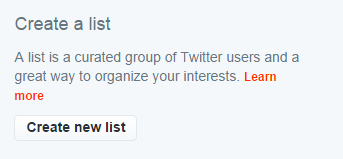 Step 3: Ask or find their email addresses. You have two options: send them personal messages and ask if they can give you their email addresses or manually search their contacts using email finder tools mentioned earlier.
Step 3: Ask or find their email addresses. You have two options: send them personal messages and ask if they can give you their email addresses or manually search their contacts using email finder tools mentioned earlier.
Step 4: Send them exclusive content via email. You can use this email template below:
Hi [Name],
I’m [Name], [Position] at [Company Name]. I saw that you tweeted my post on [Blog Name]. I appreciate it a lot.
I just want to ask if you’d been interested to check out an ultimate guide for [topic]. This is something that I’ve been working on for the past 3 months and would only want to share exclusively to my active followers.
Please let me know if you’re interested.
Happy tweeting!
Regards,
[Your Name]
5. Schedule your reply emails appropriately
If you've been doing outreach for content promotion for quite a long time now, you know that one of the important factors that affects email open rates is the timing of outreach.
If you schedule your initial outreach email at the best time your recipients would likely to open it, make sure that you also do the same thing with your reply emails.
The reason why conversations were stopped is that the second to third reply emails were received by prospects during non-peak hours. If you can schedule your reply email at the time your prospect replies to you in your initial outreach, you'll get much success from it.
To schedule your follow up emails, you can use Right Inbox.
Step 1: Open your Gmail account, then click the Compose button.
Step 2: Write your message and subject line then add your recipient’s email address.
Step 3: Schedule your email at the time your prospect replies to your initial outreach.
Step 4: Send your email.
Further reading
6. Use your preferred anchor texts when describing your content
The old school way of letting your link prospect know about which anchor text you prefer to be used (in linking to your content) is to directly tell him the anchor text (e.g. Would you please link to me using this anchor text: payday loans).
That link building practice won’t get much success today as it will make your email look like spam.
One way to actually make this linking practice still work is to add some phrases to your email to describe the content that you want to promote.
How to do it?
Step 1: Edit your email template. Instead of only using these texts– if you want to check out my post, you can click on this link, you can actually add some descriptive phrase to your email.
If you want to check out my broken link building guide, you can check out this link: (link here).
Step 2: Add your subject line and your recipient’s email address.
Step 3: Click the send button.
7. Use popular hashtags in your tweets
Hashtags add more social visibility to your tweet, making it easy for your tweets to be seen by active social participants other than your followers.
If you will add popular and relevant hashtags to your tweets, you will have chances of increasing your tweets' social discovery.
How to do it?
Step 1: Go to BrandMentions' Hashtag Tracker. Scroll down the page and look at the popular hashtags section.
Step 2: Use relevant hashtags to your tweets. If you are in the business niche, you can regularly use the hashtag “sales".
Step 3: Do it religiously.
8. Reduce link noise ratio by estimating the number of external links
Obtaining a link from a resource page is tough these days as there are a lot of success factors that will make your broken and resource page link building works, including:
- Relevancy and utility of the content suggested adding to the page.
- Real purpose of the page listing all the links and resources in it.
Another success factor to consider is the number of external links in a resource page.
If there are too many listed links, the probability of earning the link is low and the value you’ll get from it (if in case, you earn that link) will be diminished by the dissemination of page authority to several external linking pages (the higher the number of external links, the lower link juice you’ll get).
The main point is to find a relevant resource page that have a fair amount of external links.
How to identify the number of external links in a resource page
Step 1: Plug in the URL of the resource page to Ahrefs.
Step 2: Go to Outgoing links tab – Linked Domains.
Step 3: Look at the number of results. If it is more than 100, then find another resource page to prospect on.
The reason why you need to consider the number of external links is to increase the probability that you’ll going to get the link once you start reaching out to the target linker. The higher the number of external links in a resource page, the lower the chances of earning your desired backlink.
9. Use manage subscriptions link instead of unsubscribe link in your newsletter
When people are not satisfied with your newsletter content (email), they usually want to find the unsubscribe link to get rid immediately of all your future promotional emails.
This will obviously decrease the number of your subscribers in your email list.
But you can avoid people to unsubscribe to your blog but at the same time allowing them to do it if they decided to do so.
How?
Step 1: Go to your email marketing tool settings (for this example, I use Mailchimp).
Step 2: Go to settings (for Mailchimp: Campaigns – Design). Then select a template.
Step 3: Edit the footer section by changing the unsubscribe text to manage subscription.
Step 4: Click Save & Close button.
10. Build links from non-English blogs
If you limit your link building strategy to relevant niche and local blogs, you will be boxed with link opportunities surrounding your space only.
But if you go a step further and look for non-English blogs that can translate your content to other languages, you’ll find much success with it in terms of building high quality backlinks.
How to do it?
Step 1: Use your descriptive keywords as your search queries and add the site search operator to it (e.g. online marketing blog site:.fr).
Step 2: Populate your list by prospecting more related non-English blogs. Use the related search operator as your search query.
Step 3: Reach out to your list of non-English blog owners and ask if they’d be interested to translate your content to other languages and publish it on their blogs. You can use this email template below:
Hi [Name],
I’m [Name], [Position] at [Company Name]. Heads-up to your recent post about [topic]. Thanks for sharing it.
By the way, I’d like to share my recent link building guide on [topic]. I’m wondering if you’d be interested to translate it to [language].
Please let me know your feedback.
Thank you,
[Your Name]
11. Interlink relevant client posts
If you’re working on several link development campaigns that are all in the same industry, you can maximize every post/page you’re getting links for each of those campaign.
However, you have to be careful with it because you don’t want Google to see some kind of footprint in your campaigns. Make sure you include your client’s domain to your other client’s target page when they are only relevant to each other.
Here’s how to do it.
Step 1: Find a topic that will allow you to include two separate domains of your clients in a single blog post (assuming in this example it is a guest contributed article).
There’s no tool that you can use here. Use your brain. Be creative and target a non-very specific topic as much as possible.
Step 2: Write the post.
Here are a few things that you can consider when you want to apply this approach:
- Use list post as your content format to make it easier for two domains to be included in that single post (just make sure both domains have the same offerings – e.g. both have Wordpress plugins).
- Use one domain as your example (in case you want a case study type of post) and just link to the content page or category page of your other client’s domain.
- Use one domain’s image (link to the homepage URL/post URL if possible, not to the attachment URL) as your featured or secondary image, then just contextually link to your other client’s domain from the same blog post.
- If there’s no chance to include both domains, don’t try to do it (always remember that one post must have one message/information to discuss about).
Step 3: Publish and promote the post.
If you’re handling multiple clients (4 or more) all in the same industry, you can maximize all your linking opportunities by following this content promotion strategy.
Even if it is an image linking to a homepage URL of one of your client’s domain, it is still worth it, especially if the page/post is relevant to the domain.
12. Produce regular round-up posts on Google+
If you’re still not leveraging Google+ as one of your content promotion platforms for your brand, then you’re missing a lot of marketing opportunities.
Posting weekly roundups on your Google+ profile can help you in so many ways, such as:
- Increasing your Google+ engaged followers.
- Build connections with Google+ influencers particularly those authors of articles you’ve mentioned in your round-ups.
- Amplify your content through link inclusion in the round-up, engagement (+1s, share, etc..) and sharing activities from Google+ influencers in your space.
Here’s how you can effectively apply this technique to your content promotion plan.
Step 1: Create a list of weekly popular content (slide decks, articles, guides, courses, etc..) in your industry. You can quickly find them on your niche community site (for online marketing niche, you can visit Inbound.org to find daily best articles).
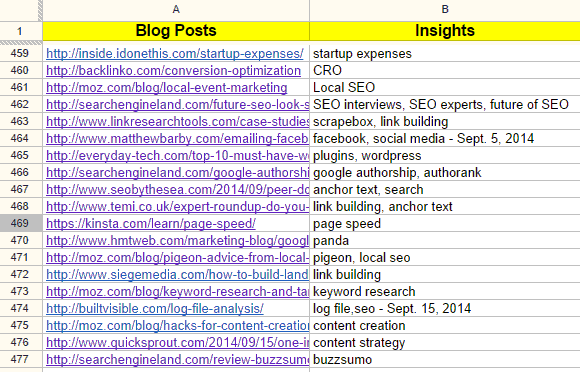
Step 2: Write your Google+ post. You can follow this simple format.
Use categories to classify your list of resources and to add hashtags to your post (which can help increase the post's visibility and popularity).
Write a call-to-action at the end of the post to encourage your social followers to check out your next roundup posts.
Step 3: Promote your Google+ weekly roundup.
To promote your roundups, you can share them to your email subscribers, site visitors (by linking to it from your blogroll links) and on your Twitter profile.
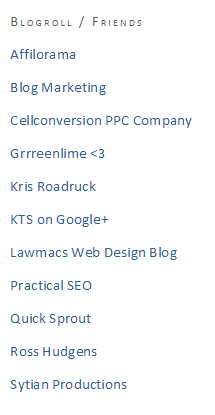
Posting weekly roundups with links pointing to your site’s internal pages is better compared to single posting of your article on Google+. Your roundups could earn more social shares and +1s than your self-promoting posting on that social platform.
13. Increase homepage links with simple email outreach
Choosing between a homepage link and a deep link, when pursuing links, is still a debate today.
In my opinion, both have benefits to your website:
- Building links to your homepage could pass authority and link juice to your sub-pages and posts.
- Deeps links will prove that your other pages/posts aside from your homepage are serving your visitors appropriately.
Let’s move on to building homepage links to your website.
Here's how you can do it.
Step 1: Export all links pointing to your website (whether homepage or deep pages). You can use any of your favorite link building tools (Ahrefs, OSE or Monitor Backlinks).
Step 2: Remove unnecessary columns and only remain columns for page rank (Ahrefs rank), referring page URL, referring page title, number of external links, link URL and link title).
Step 3: Sort by Ahrefs Rank and Domain Rank (highest to lowest).
Step 4: Check out corresponding referring page URLs of non-homepage links in the Link URL tab. (e.g. if you see a www.domain.com/blogpost in the Link URL column, and its corresponding referring page URL is www.referringdomain.com/blogpost1 , then visit the latter URL).
Step 5: Identify if the deep link placed in the referring URL can still be changed to homepage URL. You can consider the following things:
- If contextually placed within the content, check if it makes sense to replace the link with homepage URL, i.e. it will not deteriorate the overall message of that section of the content.
- Identify descriptions to the link (e.g. According to Moz, the large portion [link]). If it mainly describes the content to the site’s inner page, then it could be impossible for content managers to edit the text and link.
Step 6: Reach out to the content manager and ask to change the deep link to homepage link. You can use this email template from Ross Hudgens.
Hey NAME,
Thanks so much for covering our recent article. QUICK CUSTOM RESPONSE TO COVERAGE.
Anyway, I’m reaching out today with a small request – is it possible to link to our homepage, http://WEBSITE.com where you mention BRANDNAME on the post? I think it would add additional value/context to your readers, and of course, would be much appreciated as well.
Thanks so much for considering and if nothing else, consider this email a thanks!
Cheers,
NAME
14. Tag and category-based infographic promotion
Infographic marketing is not a common content-based initiative today. Several brands had already invested into this content creation process because of the value infographic could provide to a certain brand or website (i.e. reach, branding and SEO benefits).
The common outreach practice for infographic promotion is asking the webmaster if he/she is interested to publish the infographic on his blog, share it to his social followers and get the link that the brand deserved.
There’s nothing wrong with that. But if you can add a few tweaks to your outreach email, you can help your infographic earn more shares and natural links from researchers and bloggers.
You can add these lines to your email:
Thank you for allowing us to publish our infographic on your blog. Could we request something? Is there a chance to put some tags on it (tag 1, tag 2, tag 3) and put it under [Site’s Category] to let your visitors find the image easily.
Thank you.
The more your infographic becomes visible on several tags and properly categorized on the hosted blog, the probability of earning more page views is higher.
15. Customize your site’s search box for most commonly used keywords
Optimizing your site search can help your visitors convert to customers (see this ConversionXL post for more information).
Site search optimization is not only good for conversion rate optimization but also for adding visibility to your most important pages (those that already gained popularity and authority in your space).
When people search for specific terms that are visible in your search box, your authority pages (e.g. top blog post) will normally be placed in the top spots of search results and thus, can earn additional shares and links from people who’re digging information from those pages of your website.
Here is a great post on ConversionXL that will walk you through customizing your site’s search box.
16. Build relationships with active members in niche content-upvoting sites
This technique will depend on whether or not your industry has websites where you can submit your post and be upvoted by other users (when found to be of high quality and useful for them).
Examples of these content-upvoting websites are Reddit and Hacker News.
Getting your content to top page for those websites in the category of your choice would need connections with active memebers in order to rank easily in those sites.
You can follow this step by step guide.
Step 1: Search for active members in your niche’s community website.
Step 2: Research on their personal blogs or websites, contact emails and social profiles (simply do a Google search for their names to find those basic details).
Step 3: Reach out to them and build relationships.
17. Monitor resource pages and discover newly founded broken links
If you are using broken link building for your marketing campaign, then this content promotion technique is for you.
Resource pages are not constant in nature. Webmasters and content managers constantly update links pages with new resources and remove any resources that have no content in them (404 pages).
If you already executed an outreach campaign for resource page link opportunities before, then you may want to go back again to your list of link prospects.
What to do?
Step 1: Visit each of the resource page included in your list and check for new broken links (you can use Domain Hunter or Check My Links tool).
Step 2: Update your list with new founded broken links.
Step 3: Reach out again to resource page owners with broken links in their pages.
Pro tip: Take note of newly added content to resource pages and discover pages linking to them. This will help you find more link opportunities for your website.
18. Community-based guest blogging
Guest blogging is not dead. SEOs are still using it in the right way to show their industry expertise and increase popularity for their websites through links acquired from referring domains.
Blogs with built in community are the best places to get links from given that you do not only get some SEO benefits but a ready to engage people that can help promote your content.
How to do it?
Step 1: Go to Reddit and look for the reddit sections that are related to your industry (simple type in your keyword in the search box).
Step 2: Visit the top pages in your reddit niche section.
Step 3: Identify if there’s an opportunity to contribute content to those discovered blogs. Look for guest blogging guidelines or contribution page, or simply reach out to site owners and ask if they are interested for a free content (guest post).
Step 4: Contribute content to those websites.
19. Add print this page button to your page
Online marketers love to add social sharing buttons to their webpages but tend to forget adding print this page button to pages or content that can be used as references for educational purposes.
A few benefits of adding that print button to your page:
- Allows visitors to share your page offline to their colleagues (after printing it on hard copies), which puts more eyeballs to your page
- Entices researchers to understand and learn information from the page, referencing it for their own content works.
Check out these resources to add print page button to your pages:
20. Strategic internal linking
Internal linking helps your non-ranking pages get promoted from pages that already have high page authority and have some domains already linking to them.
If you’re still new in blogging, you won’t get much success with it, but as time goes by, your readers or fans will begin to read more of your pages not just the blog post that they landed on the first time.
And this is where internal linking helps. It attracts people to read more of your content, which will later on translate to links and shares (when these people start to reference your works from their websites or just share it to their social followers).
Here’s how you can do it.
Step 1: Go to your Google Webmaster Tools account – Search Traffic – Search Queries
Step 2: List down all search queries with high impressions and CTR but have low Average position (low average position means that they’re not ranking high in search results).
Step 3: Check what pages on your website are targeting those search queries or keywords. Then include them also in your spreadsheet.
Step 4: Go to Open Site Explorer. Plug in your website into the tool and check the Top Pages section.
Step 5: Link to non-ranking pages (pages that have low average position) from your top pages in OSE. Ensure that linking pages are topically relevant to each other.
21. Entice engagement through Recent Comments plugin
One of the main goals of blogging is to increase page views and time spent by visitors on the site through engaging them in the conversation or comment platform (below each blog post).
You can achieve that goal for your campaign if you can add a recent comment section on your website.
Here is an example of a recent comment section on SEO by the Sea.
How to do it?
Step 1: Install Recent Comments plugin on your blog.
Step 2: Make your community aware that your comment section exist. Share it to your social followers.
Add these simple lines to your status updates.
Hey guys, you can now see recent comments on my blog [attach screenshot]. :) Let’s talk in the comment section.
22. Fix two widgets on your sidebar
Remember the fixed widget plugin?
You will use it again in this content promotion strategy.
The process is very simple. You fix two widgets in your sidebar to increase your chances of achieving any of your two main brand-related goals.
For instance, if your goals are subscription growth and social following boost, then you may want to fix your email opt-in form and social profiles widgets.
How?
Step 1: Login to your Wordpress account. Go to Appearance – Widgets. (Make sure you install Q2W3 plugin)
Step 2: Click Primary or Secondary sidebar.
Step 3: Click on the widgets that you want to fix on your website. Then check the Fixed Widget check box.
Because you have two widgets to display on your website (which is very visible even if your visitor scrolls down to the bottom of the page), you have high probability that the visitor will click any of the two options: subscribe to your newsletter or click on your image pointing to your resource page (or content).
 23. Regular content contribution for blogs with huge email lists
23. Regular content contribution for blogs with huge email lists
Bloggers are now revealing their email list numbers on their blogs (see examples below) to help them built trust to their target audience and capture their emails through the opt in forms.
If you’re planning to do regular content contribution on popular blogs, then email list number should be one of your deciding factor when identifying if a blog is worth submitting your guest posts to.
Further Reading: Free Responsive Email Templates
24. Use branded photos for content promotion efforts
Visuals or images help users to depict in their minds the information they consumed from your content. It also helps them understand easily the message being presented in the article or page.
You can actually use images (particularly branded images) to get more exposure for your content (image content promotion).
Take a look at this simple image below. Did you know that it has been used 700+ times on the web?
Images can give you links that are properly attributed to your domain. With that benefit, it can help you increase your domain authority as well as the authority of the page being linked to (where the image is included).
Here is a step by step process on how to maximize images for link building and content promotion purposes:
Step 1: Find a non-licensed image to edit as your featured post image. Do a Google search for a term/phrase and click Images.
Click on Search Tools – Usage Rights – Labeled for reuse with Modification.
Step 2: Save the image of your choice and edit it using image editing tools like Pixlr and Canva.
Step 3: Include the image to your article, whether it is for your blog or guest blogging.
Step 4: Track non-attributed images using Tineye. Simply upload your image to see image results.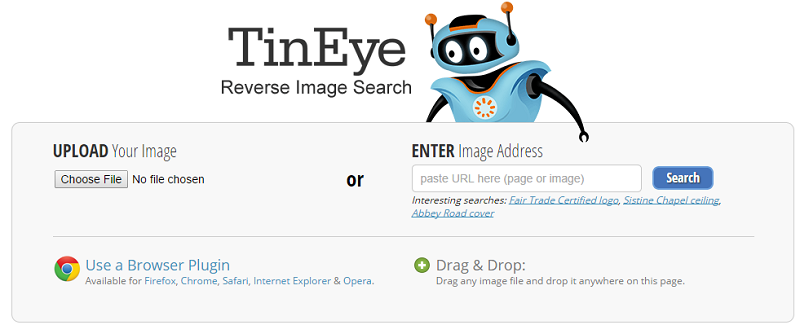
Step 5: Sort by newest links.
Step 5: Check each and every page if they have links pointing to your domain. If a page is not linking to you, find its email address and reach out to the site owner or blogger. You can use the email template below:
Hi [Name],
I’m [Your Name], the [Positon] of [Company Name]. I’d like to thank you for your including our image in your latest article about [topic]. Much appreciated.
Is there any chance you can mention our brand as the source of the image and link to our website? Please let me know if that is possible.
Thank you again. Hoping to hear feedback from you.
[Your Name]
25. Use list post for content distribution efforts
Brian Dean shared a very simple guest blogging process on Backlinko that will get you results for your SEO campaign.
It’s all about using expanded list posts for guest blogging. Just like a simple list, you curate things, tools, resources or tips that are useful for your readers. But in every item on the list, you include detailed sections or put a step by step guide on how to actually do it. This makes it easy for people to extract information or understand clearly each item on your list.
This image below is a screenshot of my old guest post on Search Engine Journal. It is a good example of an expanded list post.
It currently ranks for the phrase link building tips and white hat link building.
Conclusion
Creating content is only half the battle. You’ve got to figure out how you can win in the competition by executing any of the above content promotion strategies.
If you have a content promotion strategy in mind, let me know in the comment section below this post.
If you liked this post, you can subscribe to this blog or follow me on Twitter and Google+.
12 Link Search Tactics to Prospect Thousands of Link Opportunities
Link search is a phase in a brand’s link building campaign wherein most of the building efforts will highly depend on. This is where the success factors of link acquisition are noted, including:
- Obtainability of links, considering the types of links being built (contextual/site-wide, local/international, homepage/deep link, etc..)
- Standard or quality of content existed in various blogs/sites
When done right, link search will provide you thousands of link opportunities that your competitors may haven’t search for.
Below is a list of 12 link search tactics that you can use to create a giant spreadsheet of link prospects that you can later on reach out for link acquisition.
1. Advanced search query
There are many advanced search queries that you can use to prospect link opportunities based on the link building model you’re working on, but there’s only a handful of them that can help you find high quality link targets.
Thanks to Garett Brown that he took time to create this link search query builder. It is a very useful tool to semi-automate link prospecting targeting very niche-specific pages/sites, which are yielded from the keywords, search type, TLD and link type used in searching.
This is the most basic link search tactic that every new link builders must know. If you’re going advance, then you can read the following resources for more knowledge about link prospecting.
Useful Resources:
- Advanced Search Operators Guide: Tips for Searching the Web from SEO Experts
- 21 Link Builders Share Advanced Link Building Queries
2. Topical blogs
If most of your efforts revolve around building relationships with bloggers, then finding topical blogs is the best link search method for you.
Simply do a Google search (“industry” blog) for niches that are not directly connected to your brand but have a community of bloggers who might be interested to link to your page(s).
For instance, this link building blog is focused more on content marketing and link building topics than other internet marketing themes. But even though, I got high quality links from related sub-niches such as CRO, blogging, web design, affiliate marketing and student blogs.
If I would want to expand my link territory, then I can use the following search terms when prospecting for link opportunities, knowing that other niches might find my posts useful for them and probably link to my blog from their own content:
- “CRO” OR “conversion rate optimization” intitle:blog
- “Web design” intitle:blog OR “blog”
- “affiliate marketing” intitle:blog OR “blog”
In this link search method, you have to find the relevancy point between these niches and your brand, i.e. when you do outreach, you must be confident that they’re going to respond to your pitch because they are interested to what you offer.
3. List of lists
List posts are everywhere. And creating a list of these lists will give you hundreds of blogs that you can take advantage of for link building.
Searching for these list posts is easy. You can use the following search queries:
- Top 10 “industry”
- Top 50 “industry”
- Best of “industry”
- Ultimate list “industry”
If there are no list posts in your industry, then create one for your blog. You will have both a list of blogs/bloggers (that are potential linkers) and an added-value content that you can use for your pitch (telling bloggers that they’re one of your followers, as such, you included them in your latest content).
4. Brand partners
Putting brand partners in a list of link targets, for some marketers, would only be applicable for big companies who already had an opportunity to engage with other local and niche brands in the past. Since they had a database of existing partners, there’s a high chance to involve them into the company’s link development campaign.
However, for small to medium sized enterprises, there are still partners that they might consider for link acquisition such as the following groups of people:
- Suppliers / manufacturers who are connected to the brand.
- Local non-profit organizations where the brand had engaged in the past (i.e. sponsorships).
- Local educational institutions with specific courses directly aligned to the company.
- PR companies or news reporters who had just covered the brand for some good stories.
These groups of people can become your list of brand partners, wherein you can easily earn their trusts because of pre-existing relationships with these institutions.
For an ecommerce client, you won’t go anywhere else finding those brand partners. Just look at their website, find a page that says, “List of suppliers/manufacturers”. Start prospecting from there and add all potential link targets to your spreadsheet. However, if there are no existing pages like the example earlier, then simply do a Google search to find you brand partners.
5. Market-centered keywords
One of the key ways to collect profitable link prospects in your database is to understand your market and what your target audience is really looking for online.
For instance, if you’re working for a travel agency, you might consider industry phrases that’ll identify your market needs, such as:
- Travel list
- Travel guide in 2015
- Travel guide in [city/location]
- Best places to see in [location]
- Travel blog with pictures
As you can see, these are the exact phrases people are searching for online to find relevant resources or content about travel, “why” and “what” type of search terms (what is travel) is insignificant to the market needs since people are more likely interested with how’s (map of going to specific location) and when’s (dates/times of best attraction in the city).
6. Search dependent on content contributors
Showcasing your brand’s expertise through blogging (i.e. regular contribution on other related blogs) can drive traffic and referral visitors to your website. When using this approach, the common way to find prospects for guest blogs is adding the terms (“write for us” or “guest post”) to search query, “industry”.
Though you can already find a handful of blogs using that link search method, it won’t guarantee that those blogs are high quality and could provide value to your site (referral visitors and potential conversions).
One profitable approach to prospect for content contribution blogs is finding the best author/blogger in the industry or determining the most active content manager/marketer of your competitor.
Adding the name to the following search queries will end up having a bunch of blogs where the author had contributed his content to:
- “[Name] is a content contributor for [Competitor Domain].com”
- “[Name] is the author of”
- “[Name] is the blogger at”
- “[Name] is the owner of”
- [Name] “author” OR “blogger” OR “marketer”
So if you’re targeting 50 high quality niche-specific blogs, then using that link search approach above could easily help you achieve your goal.
7. Footprint prospecting
Finding footprints of your competitors can quickly help you search for low hanging fruits in link building. However, to some extent, if it is done in a regular basis and this is the only approach you’re executing, then you shouldn’t expect a higher competitive advantage over your competitors (since obviously, you’re just following what others had been doing in the past).
If you’re still building your brand from scratch, you can use footprint prospecting to find bloggers that you can connect with through blog commenting. This traditional link building technique still works when used as a pre-engagement activity before actually pitching bloggers for link requests or other content-led outreach methods.
A quick search query ([keyword] “leave a*” “comment”) could yield a good list of blogs where you can regularly check new posts and add useful and relevant insights in the comment section (to get into the radars of your target influencers).
You may also want to seek footprints of your competitors to find new link opportunities for your brand. Do Google searches for the following search strings:
- [competitor] “interview”
- [competitor] “news”
- [competitor] “press”
- [competitor] “author”
Then click “Search Tools” – Anytime – Past Month.
Here are a few things you can see in the search results:
- Author updates in the blog posts (i.e. editing texts and/or adding internal or external links to improve the page’s ranking potential).
- Text-based and video interviews.
- Webinars, podcasts and press releases of the brand associated by the author/owner.
- Social profiles of the author or the company.
Don’t just follow the brand and its existing authors/owners. You may also want to track the following brand elements and eventually track their future mentions in other blogs/sites.
- Future staff members
- Brand partnerships with relevant brands (supplier to manufacturer relationship)
- Books names or other content assets published by the brand (i.e. whitepaper “author” OR “whitepaper” author).
- Prominent interviewer always pop up in the search results when the search string (“competitor” OR “author” is used).
This link search method requires constant changes in search strings as it would need to adapt to updates happening in competitors’ brands and its industry.
8. Customer Defining Keywords
Customers when finding products or services in search are commonly using terms/phrases that define a target audience or their colleagues (fellow members) in the industry.
So gearing your link search towards what customers are defining their group members will help you discover highly qualified prospects instantly.
For example, if you own a running blog, you can use audience terms like:
- Runner
- Marathoner
- Sprinter
- Jogger
- Trackman
You can add more customer-defined keywords to your list by going to Thesaurus and searching for available synonyms.
You can also try visiting glossary pages in your niche and looking for specific terms that define groups of audience.
Instead of using the head industry keyword to prospect for link opportunities, you can use those customer-defining keywords to build a large database of link targets. In our given example, you can have the following search strings:
- Marathoner “blog”
- Marathoner “resources”
- Marathoner “guide”
- Marathoner “links”
Changing the given customer-defined keyword to other industry audience groups (sprinter, trackman, jogger, etc..) will give you another hundreds of opportunities that you can’t find by simply using the head term (running) in link prospecting.
9. Industry Thought Leaders
This is pretty much the same with footprint prospecting wherein you use names of authors from your competitors’ brands and add them to your advanced search operators to prospect for pages/sites where those authors had been mentioned.
Industry thought leaders do not only represent companies they’re working for but media outlets, content sites, branded pages and communities where thought leaders participated and are credited for their works (by linking to their brands using names as anchor texts).
Take note of brands with attached multiple authors and personalities since partnering with them can help amplify your content assets to a larger audience list (considering the number of followers each of the author has).
Consider Moz for example. The brand doesn’t just have one thought leader (Rand Fishkin) but three or more authors that are active in the community but represents one same company (Cyrus Shepard, Dr. Pete, Jen Lopez, etc..).
In this case, learning from what the thought leaders are working to build their own personal brands will best help your campaign to identify opportunities that will give good impressions for your company as well.
You may also try to determine what topics each industry leader is focusing on. Then try to invest in certain themes (one content theme at a time), then reach out to certain thought leaders who might be interested to consume and share your content.
With Moz, authors have their own themes when creating content:
- Rand Fishkin – videos, webinars and podcasts on advanced SEO and marketing topics (e.g. Whiteboard Friday).
- Pete – data-based content with graphs/illustrations (e.g. Google Answer Boxes)
- Cyrus Shepard – ultimate guides and curated content on advanced SEO topics (e.g. Advanced SEO Concepts)
Pro tip: Adding expertise phrases of authors to search strings (e.g. “guide” “Cyrus Shepard”) would give you pages/sites where content assets of authors had been mentioned.
10. Product/Category Keywords
One of the under-utilized approaches in searching for link targets is adding brand’s categories to search strings. This method will uncover hundreds of opportunities target each and every type of product your brand is able to sell.
Start by talking to your client on what types of products they are selling or simply go their website and look for brand categories.
In our earlier example, you can have these types of products:
- Flat feet running shoes
- High-arched feet running shoes
- Neutral running shoes
- Normal running shoes
Add your favorite keywords (reviews, forum, blogs) to categories (example above) to find loads of pages/websites that can potentially link to your content.
11. Local-specific Keywords
Making your search strings tailored to a local audience helps you discover and participate with local press outlets that have high chances of driving local traffic, resulting in an increase in sales.
Combine your favorite keywords (reviews, resources, blogs) and local areas (e.g. Brisbane) to find local pages or sites. You can also be specific with cities by adding region or state, as well as Zip Codes to prospect for easy link opportunities.
12. Resource Page Terms
Seeking for link opportunities especially resources/links pages requires creativity in brainstorming for new search strings. This is true for industries that don’t have many pages for resources.
In this case, you need to understand what industry terms webmasters are using or targeting in their existing links/resource pages.
In running niche, you can be as specific as possible when doing link search (to find resource pages).
Here is an example of using very specific search terms for resource pages:
- intitle:resources OR inurl:resources “trail running”
- intitle:resources OR inurl:resources “kids running”
- intitle:resources OR inurl:resources “mountain running”
The more specific your search is, the easier for you to filter out irrelevant pages in search results and only qualify those sites that are high quality.
Pro tip: Always check out related verticals as you go looking for link prospects. This might uncover opportunities that could otherwise be undiscovered. In our example, adding these keywords “fitness resources” or “personal training” resources will help you build a large database of link targets.
Other Useful Resources:
If you’re looking for a high quality link building service, then you can contact our team to help you create a link strategy that fits your brand and industry.
9 Ways To Find Better Keywords for Link Prospecting

Research is not “good research” until it is seasoned with all the right keywords. We cannot simply uncover prospects that are relevant as well as insightful if we do not employ the correct strategies. Having said that - keyword generation is, in my opinion, the heart of every campaign. After all, how can we ever expect to reach our audience without first wielding a well-thought-out string of words?
To help us navigate the waters of “keyword inception”, let us first go back to its root. A keyword is commonly defined as a word or concept of awesome significance. For us to come up with a great blog roster, we need to make sure the phrases we use in research will coincide with those utilized by our target prospects.
Another, looser translation of the term is “password”. Personally, I very much like the concept of decoding a password in relation with finding the most effective words to use for link prospecting. Not unlike our search queries, passwords unlock a bunch of possibilities.
As you probably understand, there are a lot of factors to consider when it comes to choosing your terms. In our industry, the most commonly used keywords are categorized under three types: generic, specific, and long tail.
Let’s first take some time to understand these keyword types better before we go on.
GENERIC KEYWORDS

As the term suggests, “generic” keywords are unspecific and all-encompassing. You can expect to get thousands, even millions of results using this type of keywords. An example is using the words “food processor” in your search query.
SPECIFIC KEYWORDS
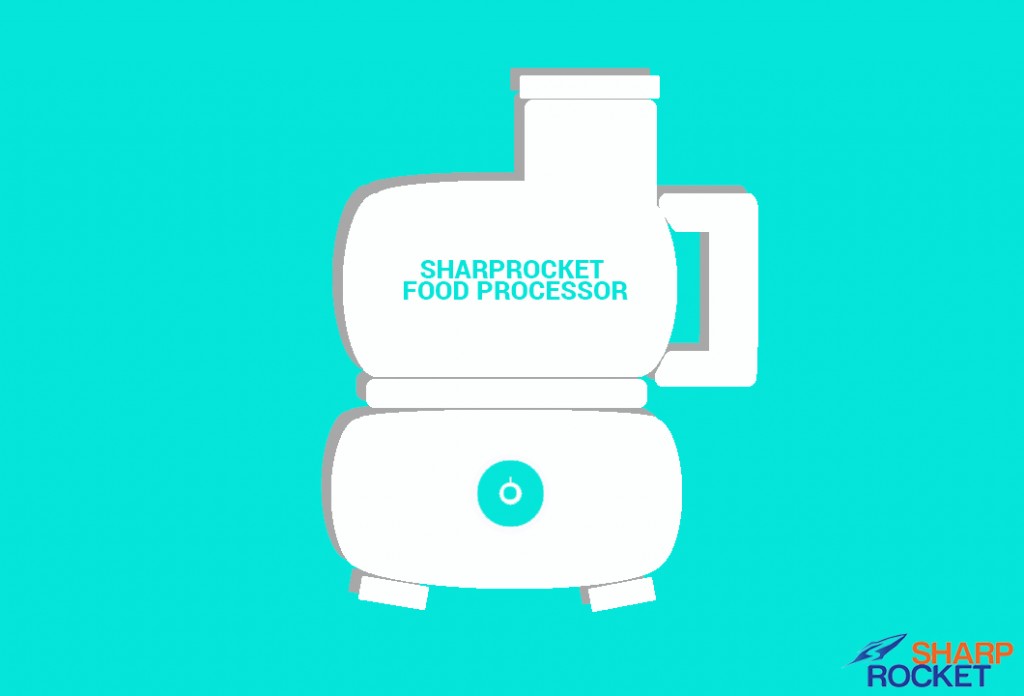
This type of keyword is obviously a lot more particular than the former. In relation with our previous example of “food processor”, a specific example would be a branded version - “SharpRocket Food Processor”
LONG TAIL KEYWORDS
Lastly, long tail keywords are most commonly phrases or even a complete sentence typed into the search bar. Now, a perfect example for this would be “best way to operate a food processor”. Basically, a set of four or more keywords is considered “long tail”.
Going back to the main point of this article, how do we come up with the best possible keywords and/or keyword combinations for maximum results? Of course, this all leads back to a rather popular answer: common sense.
1. THESAURUS
The most obvious way to come up with a fresh set of keywords is by making use of the thesaurus. This tool has, no doubt, been introduced to all of us way before we started messing around with computers. Simply put, it gives you a little index of words in groups of synonyms and related concepts.
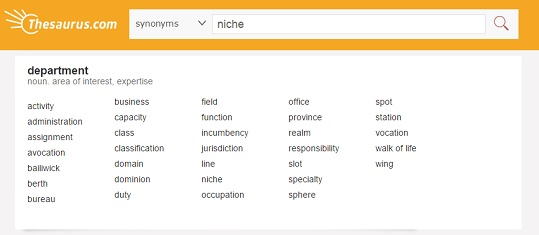
2. INDUSTRY GLOSSARY / JARGON
The Glossary of Industry Terms is a comprehensive list of words and expressions used by experts or trade specialists that may be difficult for others to comprehend. When you’re targeting bloggers who write specifically about your client’s niche, the most useful thing you could do is to familiarize yourself with their jargon first so as to come up with accurate results.
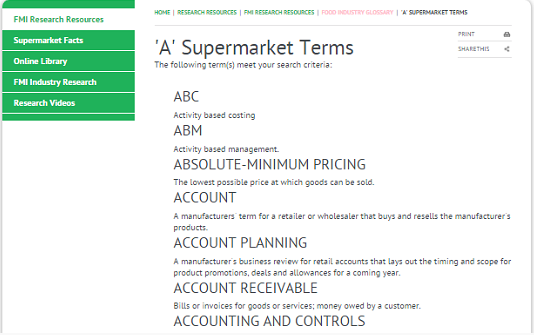
3. BLOG POST TITLES AND URL
Sometimes the greatest things in life are right in front of you. The same holds true for keyword generation. The best ones may just be under your nose. Pay attention to how bloggers construct their post titles and what words appear in their respective URLs. This might come in handy when you want to target articles that tackle the same topics or have roughly the same content. Using the same keywords but coming at it from different angles might just make the biggest difference to your research.
Case in Point: Instead of just using “online shopping” as your keywords, consider a different perspective - “pros and cons of online shopping”, “advantages of online shopping”, etc.
Sample Search Queries
- allintitle:pros and cons of online shopping
- inurl:pros-and-cons-of-online-shopping
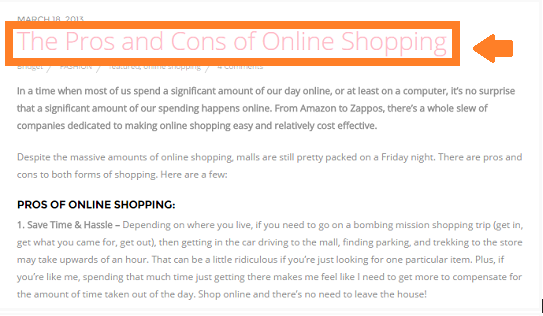
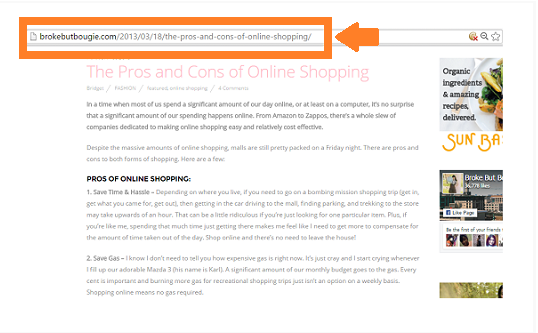
4. Wh AND H QUESTION WORDS
Since we’re on the subject of words, it’s also advisable to scrutinize the kind of language content writers commonly use. Some bloggers endeavor to answer the biggest questions about their niche with their posts. Incorporating the Wh (who, what, when, where, why) and H (how) question words in your queries will help you discover who those bloggers happen to be.
Getting links from these kinds of pages can be quite advantageous as a lot of potential customers tend to look for these types of informative articles before actually coming to a decision. Having your product or service presented to readers immediately as a suggestion can drive valuable traffic to your website.
Example: “What can you do with a food processor?”
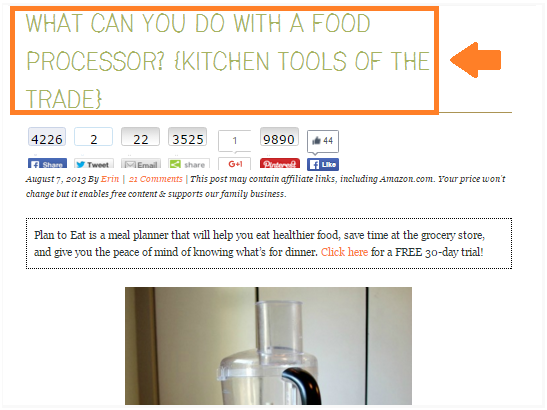
5. BE OPEN TO SUGGESTIONS
What’s easy is not necessarily wrong. For other possible keywords, simply check other Google searches related to your query. A list of phrases can be found below the Search Engine Results Page (SERP) whenever you do a Google search. Though not all of these can be helpful all the time, we do stumble upon a few golden nuggets every once in a while.
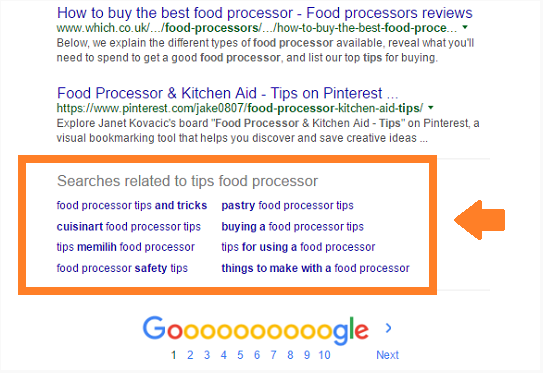
6. THINK OUTSIDE THE BOX
Don’t restrict yourself to just one set of keywords. If you find you’ve exhausted all concepts directly related to your client’s niche, try looking at the bigger picture. Don’t always work from the outside going in. Try the opposite.
If your client specializes in leather belts, don’t get stuck on keywords like “buckles”, “straps”, and “tongues”. Instead, visualize the belt as a little island in the middle of the ocean. The ocean symbolizes what niche encompasses your client’s (e.g fashion). Look for possibilities outside of what has been handed to you.

7. FINDING OPPORTUNITIES IN MISTAKES
Ever notice how people choose to dwell on another person’s faults rather than his successes? Well, the same thinking can be used for our benefit when it comes to blog prospecting. Articles that focus on mistakes, misconceptions, or myths that people believe about certain issues or topics may sound totally negative, but can present real possibilities for building links.

8. LSI GRAPH / LSI KEYWORD GENERATOR
The Latent Semantic Indexing (LSI) Keyword Generator is a tool that comes up with a list of terms and phrases related to your current keyword in a matter of seconds.
“In a nutshell, they are keywords that are semantically linked to your main keyword. In practical terms, Google has confirmed that by using more LSI keywords, your page will typically rank better.”
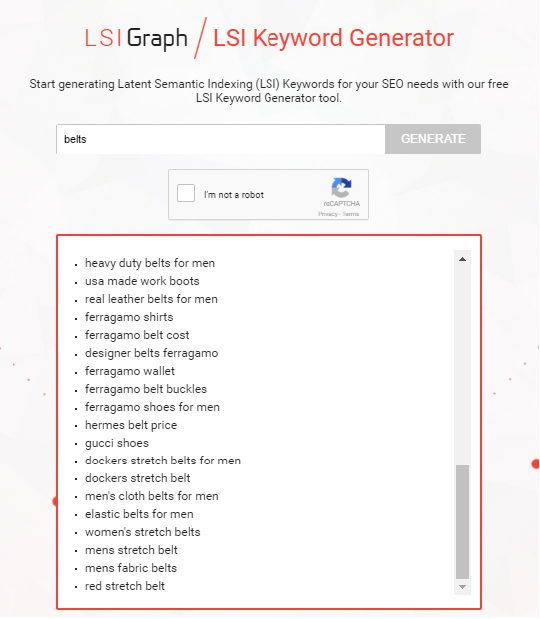
9. KEYWORD PLANNER
Keyword Planner is a Google AdWords tool that can be used by new and experienced marketers for free. According to Google itself, “Keyword Planner is like a workshop for building new Search Network campaigns or expanding existing ones. You can search for keyword and ad group ideas, get historical statistics, see how a list of keywords might perform, and even create a new keyword list by multiplying several lists of keywords together.”
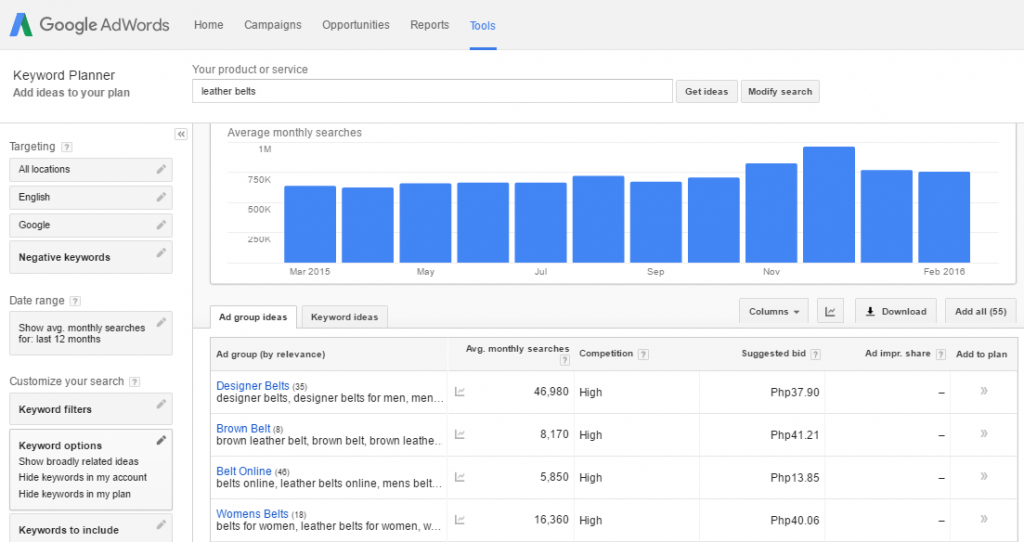
NEW ROADS LEAD TO FRESH OPPORTUNITIES
Always keep in mind that as the digital market grows, so must our creativity flow. At the risk of sounding corny, remember never to limit yourself. In life, as in link prospecting, an option is never truly an option if you only have one.
How to Use Competitor Links in Blog Prospecting

Link prospecting is not just some simple research you conduct to look for prospects. It is the initial and critical step in building links which involves creative ways to look for quality links that is relevant to your campaign. Just like what our CEO says:
Link prospecting is one of the critical and first initiatives in the link acquisition process. Every link building tactic always starts with finding links in a particular web place using free SEO tools and sorting those links in a spreadsheet based on the brand's link standards.
- Venchito Tampon, CEO of SharpRocket
We need to find techniques that will help us garner prospects in a more convenient way. Blog research itself is already hard enough because of the thousands of ways to look for prospects.
Another way to find new link opportunities and not just by Google search results, is through competitor links.
Having a competitor, may it be content or direct competitor, is not always a bad thing. It may seem to be futile, yet we can get a lot from it especially in generating new keywords and finding link opportunities to add on your list. One way of using this is through the search operator “links:”.
![]()
Our team tried this Google command “links:” when we were looking for resource pages and we found websites that were later on listed as possible prospects. However, there are also disadvantages. In this article, we note the pros and cons of using the Google command “links:”
ADVANTAGES AND DISADVANTAGES OF USING THE SEARCH OPERATOR "LINKS"
PROS:
- Since your competitors are already linking to those websites, there is a great chance that the site or blog post is relevant to your industry.
- Websites shown in the search engine results page will give you other niches to tap as you visit them.
- Usage of “links:” operator is easy and convenient unlike when you are using backlink checker tools.
CONS:
- There is a chance that you can’t find a related topic connected to your industry to link from because your competitor already beat you to it.
- In checking for competitor links, you just tend to follow the blueprint instead of standing out. Being number one sometimes requires looking for other websites that are competitor-link-free!
- Not all websites linking to your competitor are based on their preference. There are times where a blogger links to another blogger or a company just because they know the person who owns it.
UTILIZING THE ADVANCED SEARCH OPERATOR "LINKS"
“Links:” search operator points out web pages that are linked to the domain you used. SERPs will, however, give you random results from its internal links and even web ranking review that’s why we have to be selective.
HOW TO USE GOOGLE COMMAND “LINKS:”
1. Target a specific competitor link you want to use. For example, you are looking for a resource page and saw erickimphotography.com as one of your competitors. Go to Google search box and key in the search operator + the domain name of the competitor. 
Note: Make sure that there is no space after the colon.
2. Choose a url in the search engine results page that you think can be a possible prospect.
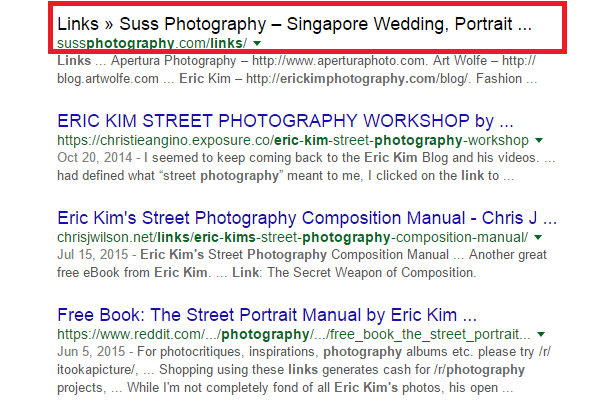 3. Use the “site:” command and type the keyword you are looking for, only if needed. In our example, we need not to use the search operator “site:” since we are looking for a resource page and sussphotography.com’s resource page already appeared on the SERP. Therefore, we can possibly link our website to this blog, too.
3. Use the “site:” command and type the keyword you are looking for, only if needed. In our example, we need not to use the search operator “site:” since we are looking for a resource page and sussphotography.com’s resource page already appeared on the SERP. Therefore, we can possibly link our website to this blog, too.
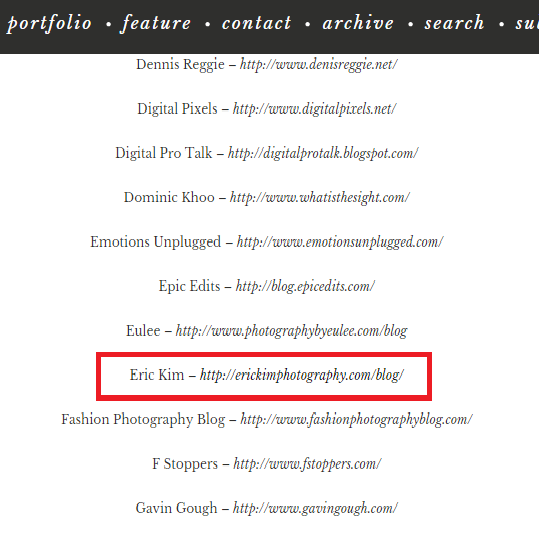 We can also use competitor links in generating keywords and phrases for our Google queries. Visiting related blog posts on their websites can somehow give us fresh ideas.
We can also use competitor links in generating keywords and phrases for our Google queries. Visiting related blog posts on their websites can somehow give us fresh ideas.
THREE C’s TO REMEMBER IN CREATING KEYWORDS FOR LINK PROSPECTING
When we do research, we sometimes tend to write words based on how we formulated it in our mind and fail to simplify terms then find ourselves easily falling into the same thinking pattern. Before we jump to the tips link builders can apply to find new niches to tap or keywords to use, below are things to consider when typing in the keywords you will use for blog research:
1. CONCISENESS
We can use words that are short and to the point as a substitute for lengthy words without changing its meaning.
Wordy: Newly Developed or Most Common
Concise: Trending or Popular
2. CONCRETENESS
Choose words which form a sharp and clean meaning to eliminate confusion as to what you are really looking for.
General: My first Investment
Concrete: My First Car Investment (stocks, bonds,house,equipment, bags etc)
3. CLARITY
Choose precise, concrete and familiar words.
Familiar words: coupon
Pretentious Words: statement of due interest
UNLEASHING KEYWORD CREATIVITY
Lateral thinking is a technique that uses uncommon approach to solve problems or to stir up fresh ideas. Yes, being concise is one smart thing for us to generate keywords for our research. However, in developing link building tactics, one must dare to think outside the box to be able to come up with new niches to tap or keywords to use.

1. Who will benefit?
Ask yourself who would be interested in the products and services you or your client has to offer then list them down. We may review the possible prospects according to their age, gender, and needs. Think of other potential customer and reader. Let’s say you’re selling skincare products and you want to advertise these, you automatically look for beauty bloggers. Aside from the obvious people who might benefit in what you have to offer, try going beyond, like mommy blogs, health blogs, and senior blogs.

2. Who are the experts?
You may also consider people who are experts on your particular topic. In our example, we may choose to search for dermatologists and estheticians who specialize in skin care.
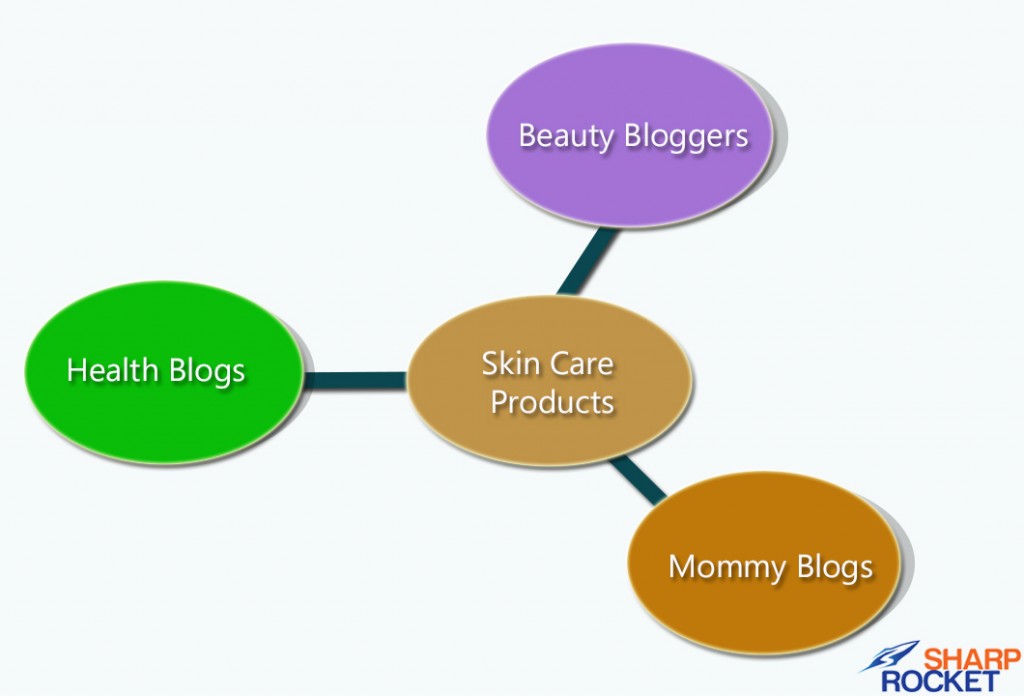
3. What are the problems encountered by niche?
There are times when you finally used up all the tricks up your sleeve and caught yourself at a loss for thinking new keywords to use. You can then try searching for the problems encountered by a certain niche. There are many terms or jargons associated with skin problems that only those knowledgeable in that field or those that already experienced it knows of.

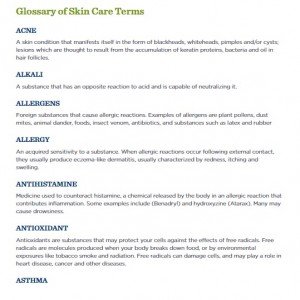
Website: https://nationaleczema.org/eczema-products/glossary-skin-care-terms/
OTHER USEFUL RESOURCES:
- How to Speed Link Prospecting Through Observations
- How to Personalize Search Queries for Blog Prospecting
- Search Engine Queries for Link Builders and Marketers
EMBRACING COMPETITOR OPPORTUNITIES
Not all links will be counted with the Google link command. Some pages that will be displayed on SERPs are not all important or relevant to what you are looking for. Yet checking websites connected to your competitors will give you an idea of where to build your links. It will provide new ideas and broader networks to associate with. You just have to embrace every opportunity that comes your way to get links or new set of keywords to use, even if these are from your competitor.
How to Personalize Search Queries for Blog Prospecting

Blog prospecting can, at times, prove to be a pretty daunting task. While you may have a ton of tricks already at your disposal,it wouldn’t hurt to consider taking another step towards developing a less time-consuming method.
At SharpRocket, I’ll admit we have grown quite fond of utilizing search operators allintext and allintitle (both of these are useful for productive search engine queries). While both are far from being revolutionary, they definitely help make life just a little bit easier.
These search operators are plenty useful by themselves. When paired with the right keywords, however, they can work wonders.
THE TWO ‘FIRSTS’ OF BLOGGING
In our experience, when it comes to blogs - there are always two “firsts”.
1. Firsthand Experience - Bloggers most commonly talk about their own lives. They share valuable insights and opinions which are purely personal.
2. First Person Point-of-View - In relating these firsthand experiences to their target readers, it is only logical that authors use First Person P.O.V.
Key Pronouns: I, me, my
FIRST PERSON P.O.V PROSPECTING
It would only make sense, then, to incorporate this concept into blog research. After all, who would ever say no to better filtered results?
Note that while this process may not totally eliminate company sites from the Search Engine Results Page (SERP), it will definitely minimize the time spent looking for prospects. And in the fast-paced world of digital marketing, I’m sure we all understand that every second counts.
Formula: allintext/allintitle + keywords + key pronoun/s
For example, if your client happens to be in the business of home improvement - consider adding one or more of the key pronouns to make your search even more specific. In this case, the more clear-cut your query is, the better.
allintext:I painted the walls

allintitle:remodeling the house

As you have probably noticed from the examples shown above, Google generated more results when I utilized the search operator allintext than when allintitle was used. Each have their individual advantages when it comes to blog research.
While allintext may offer you a wider range of possibilities to choose from, allintitle gives you a brief, condensed list of candidates. Keep in mind that allintitle is a bit harder to calibrate as you have to choose more precise keywords.
For even more explicit link targets, try using quotation marks (“,”) in your search query.
allintext:“I painted the walls”

Though this may provide you with noticeably less options, it does help narrow them down to the most relevant. Incorporating quotation marks into your queries can also spew out results which are miles more accurate than the alternative.
The obvious downside to this tactic, however, is the fact that not all bloggers speak the same way. Though you may still get a considerable number of prospects, consider how many more blogs are out there discussing the exact same topic using completely different terms or nuances. At some point, we have to think about how our ability to produce quality results may be directly related to our creativity.
PERSONAL BLOG ROUNDUPS
Commonly known by most bloggers as blog hops or blog parties, roundups are an integral part of building your network of friends and readers. They can be updated weekly, monthly or even annually. The websites mentioned in these lists, in contrast with blog rankings, are hand-picked based on content.
Chances are, most of the blogs listed under these posts are just that - BLOGS. The reason behind this may be that the blogger who compiled the roundup has at one time or another, had an interaction or two with the people he cited. I, personally, have yet to come across a blog roundup that cited company journals. The major sentiment behind these roundups seem to be, “for individuals, by individuals.”
This can also serve as your assurance that the blogs you will unearth are of good quality, content-wise. Being mentioned in these lists can be considered a nod to a blogger’s impressive work. Although you cannot expect all these websites to turn into prospects, the results you will get would still be of great significance.
Basically, our main goal here is to steer clear of blog rankings/blog directories that are based solely on website statistics (e.g Domain Authority, Alexa Ranking, etc.). As you know, these types of lists do not discriminate between corporate and personal blogs. Instead of wading around an enumeration of 100 or so top blogs that may or may not be run by individuals - try looking for blog roundups by individual bloggers.
Though the terms blog hop, blog party, and link party may sound like big no-no’s to digital marketers, it is actually what the average blogger uses in reference to what we call “blog roundups”. It is therefore advisable to use terminology which is more commonly used by content creators to generate the most results.
Saturated results can be attained by using quotation marks and/or search operator “allintitle” in your query.
Formula: allintitle (optional) + niche + blog hop/blog party/link party
allintitle:”DIY link party”
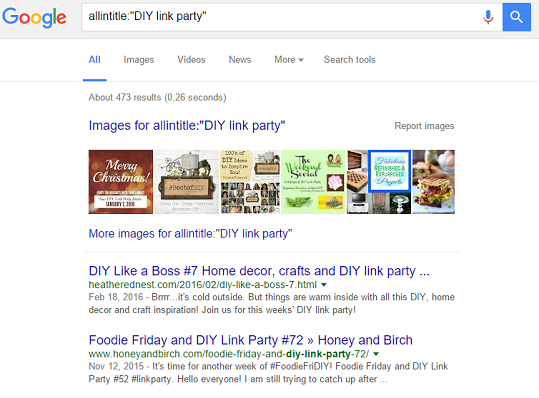
SMALL DETAILS, BIG IMPACT
Hard as it may seem, there are always new methods we can come up with to maximize productivity and minimize the time spent for blog research. Just remember that, in the end, our purpose is to establish valuable relationships with real people. Noticing small details such as the words and terms used constantly by bloggers may seem a tedious and unnecessary task, but they can sometimes lead to the best results.




